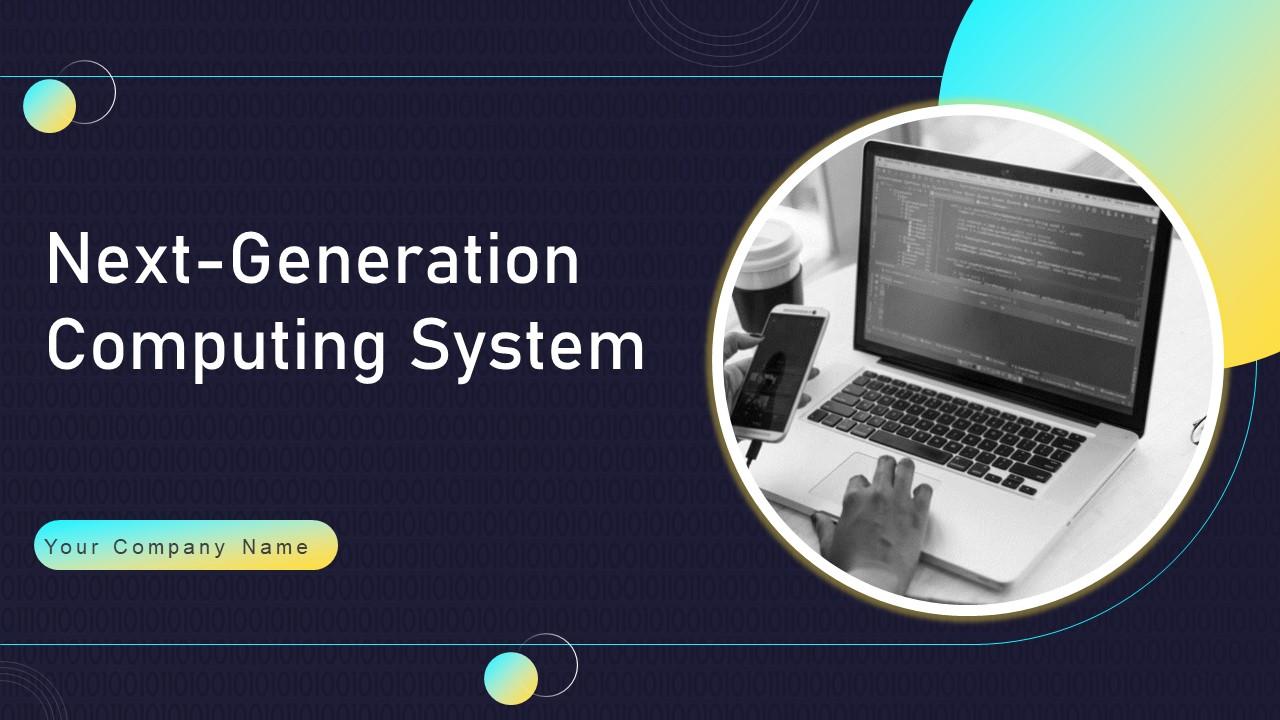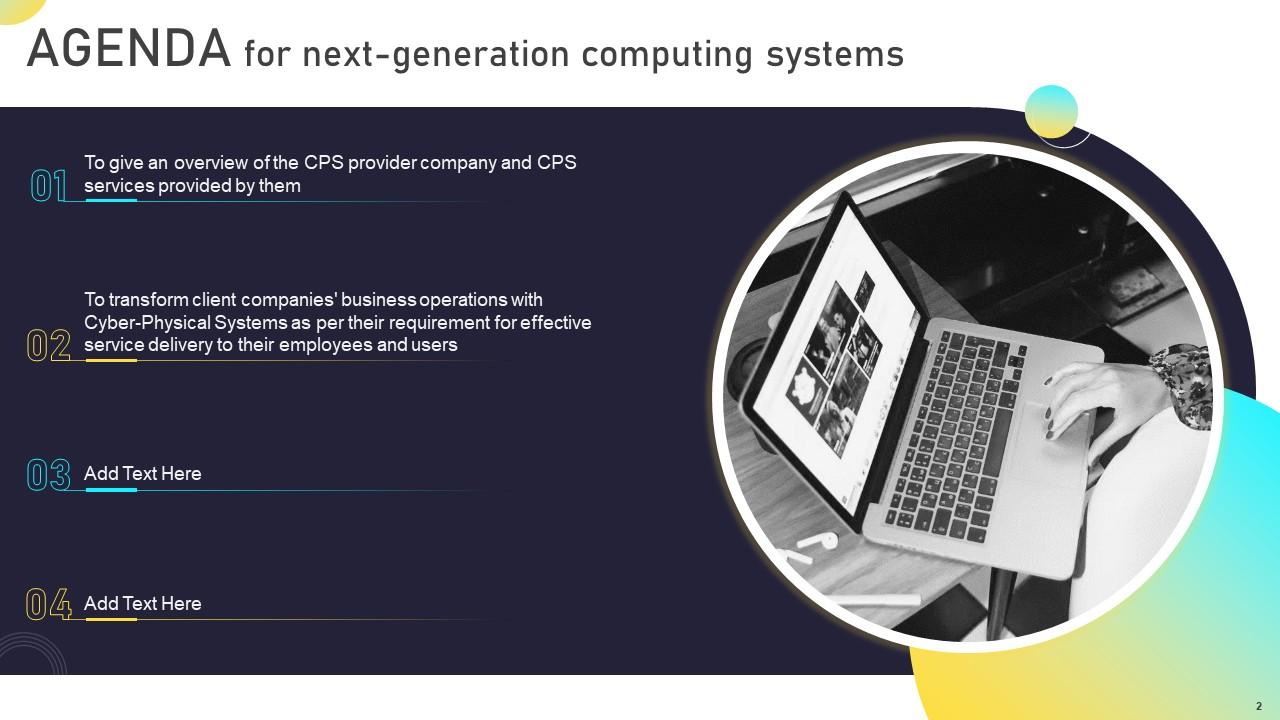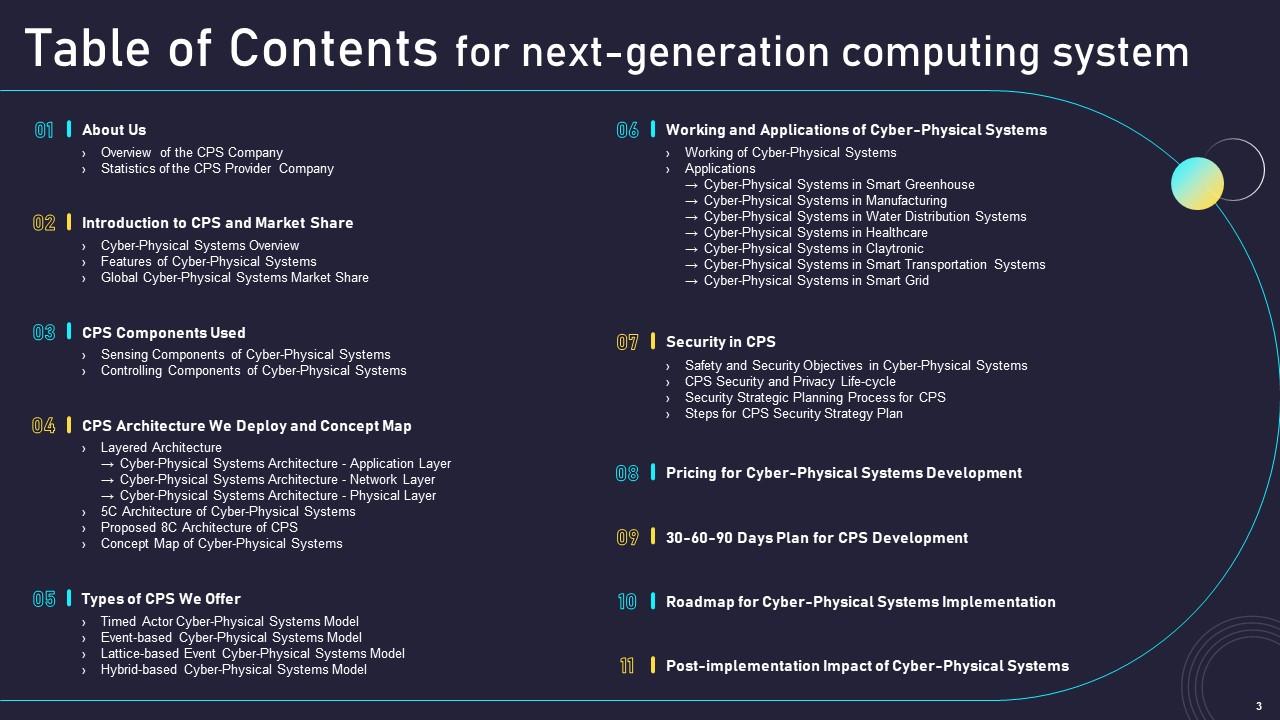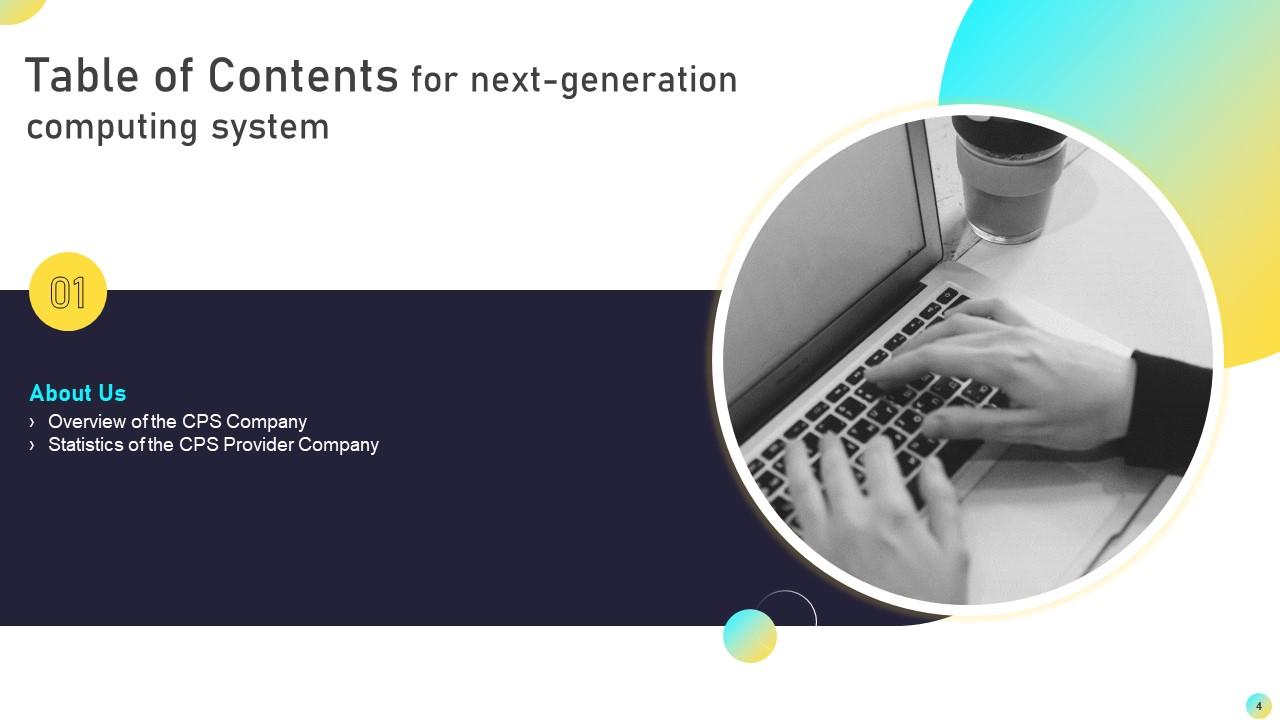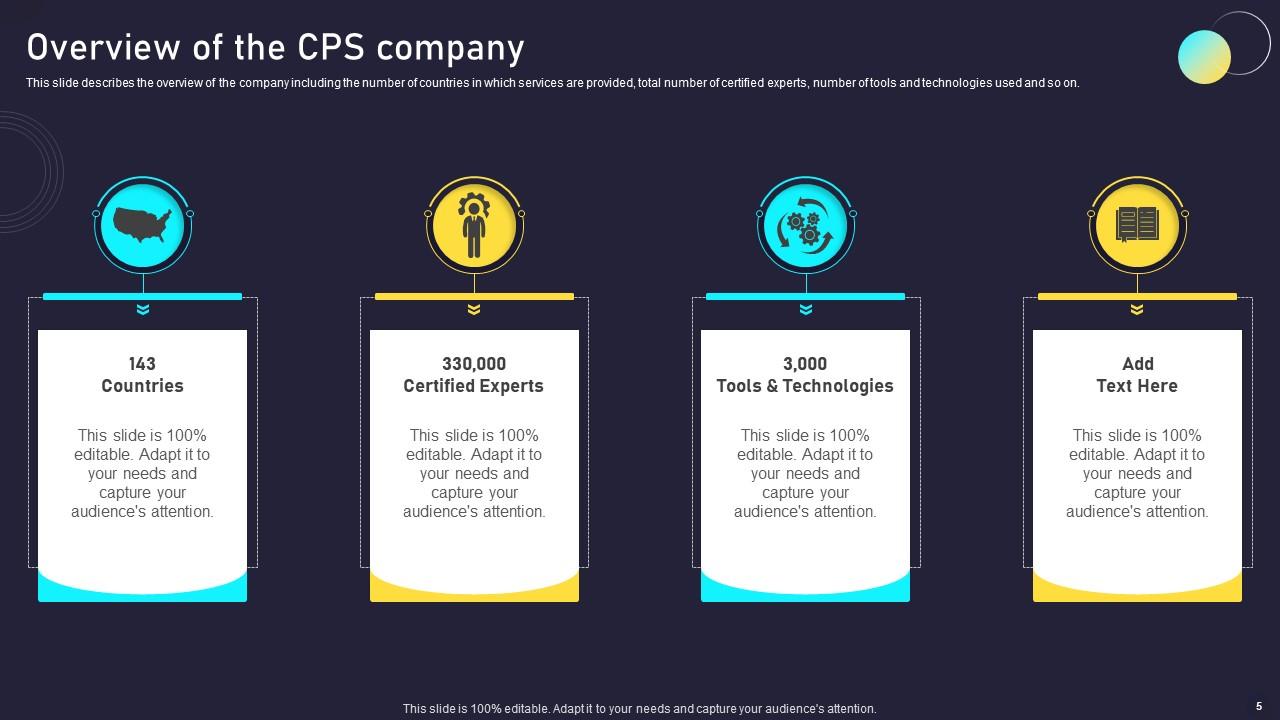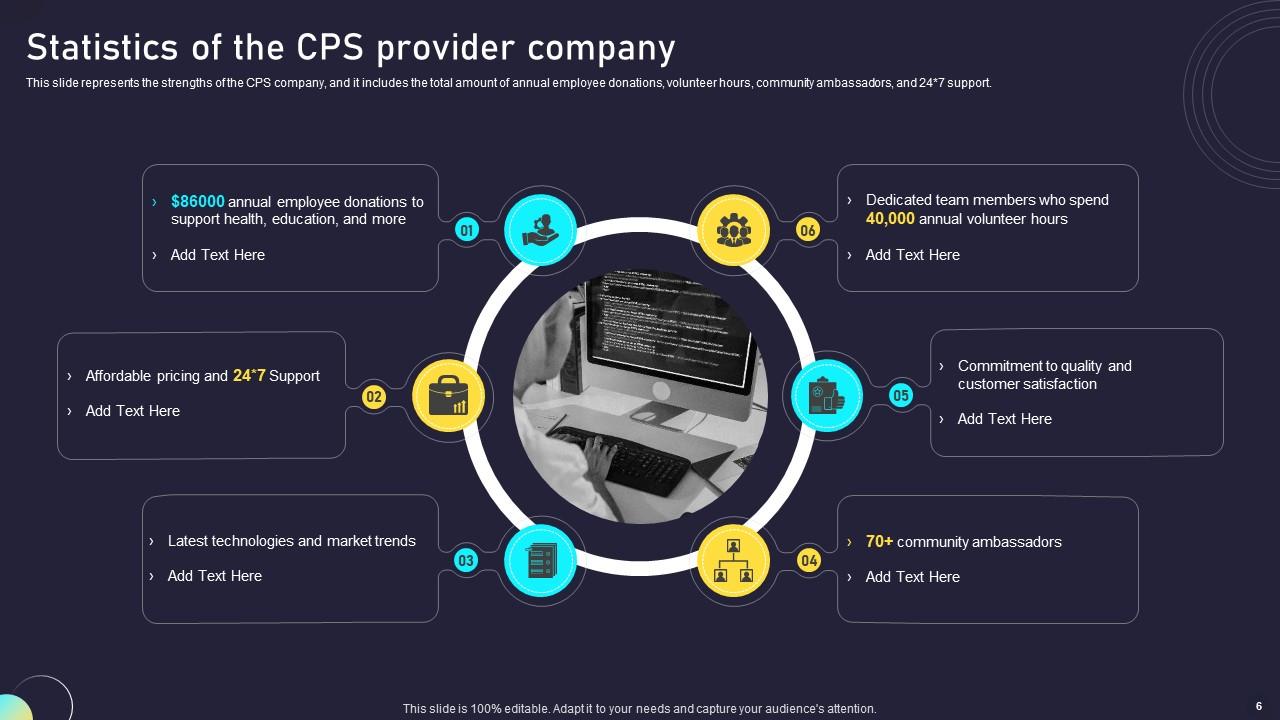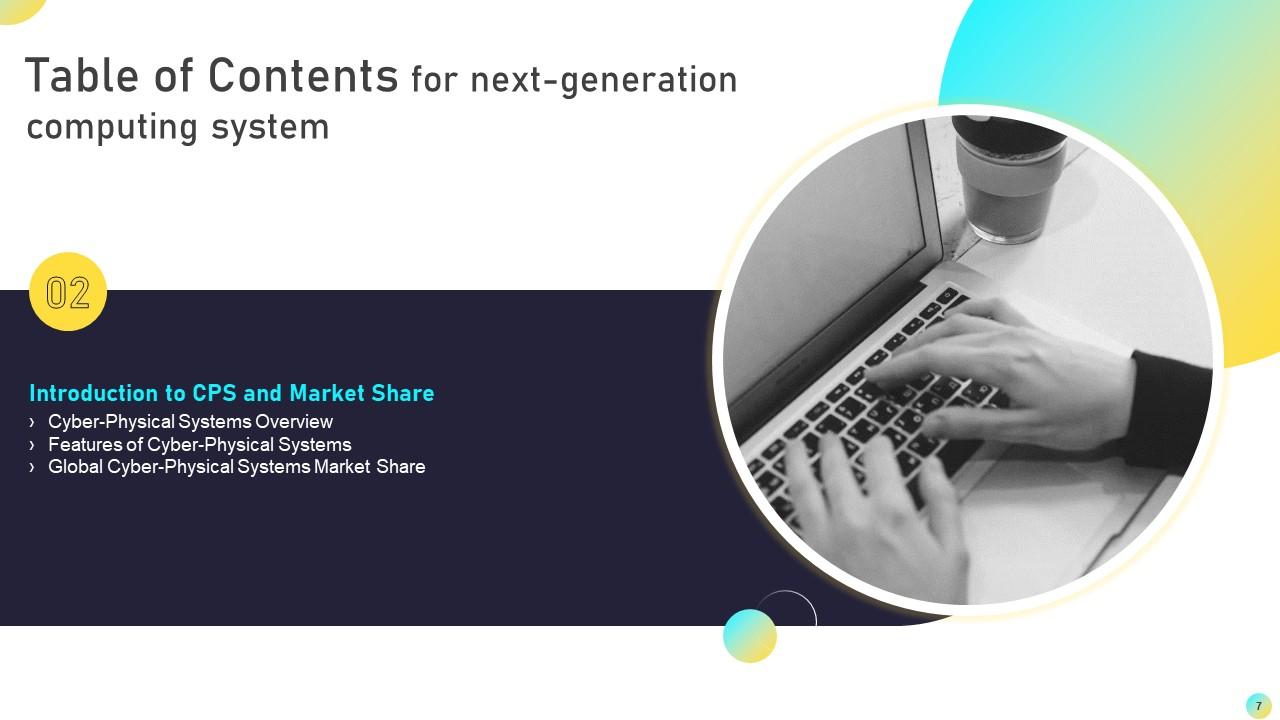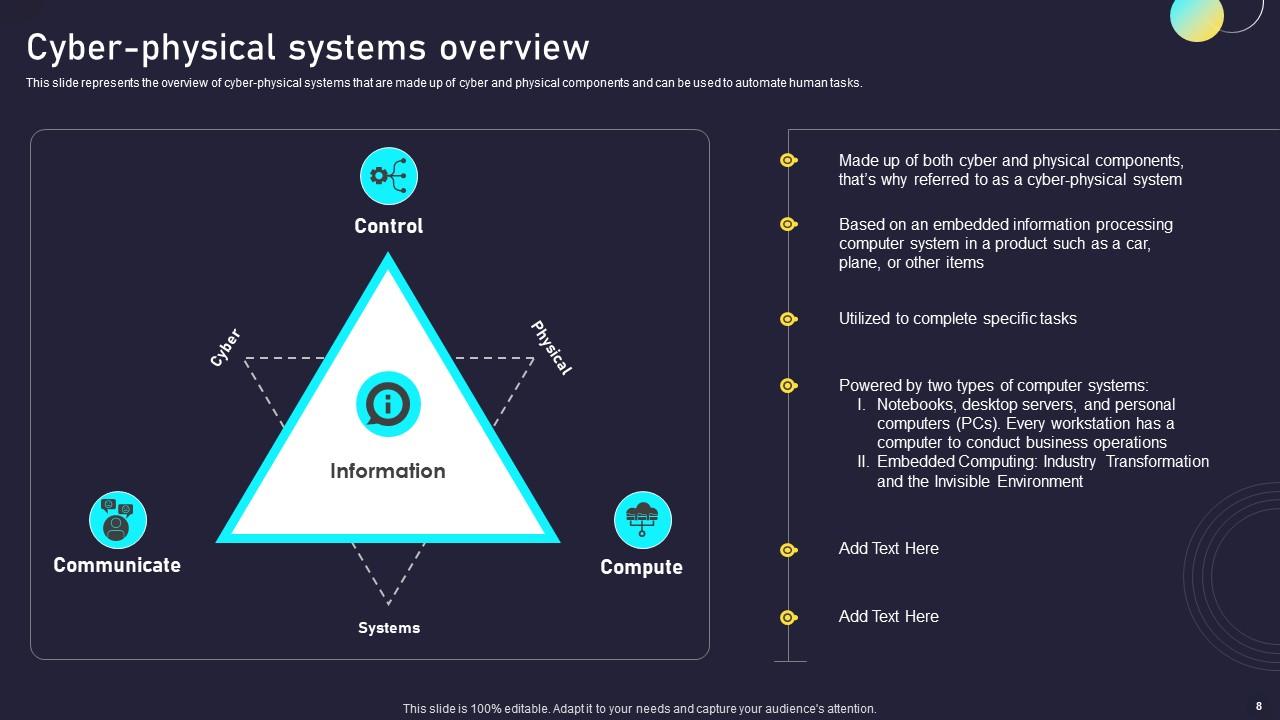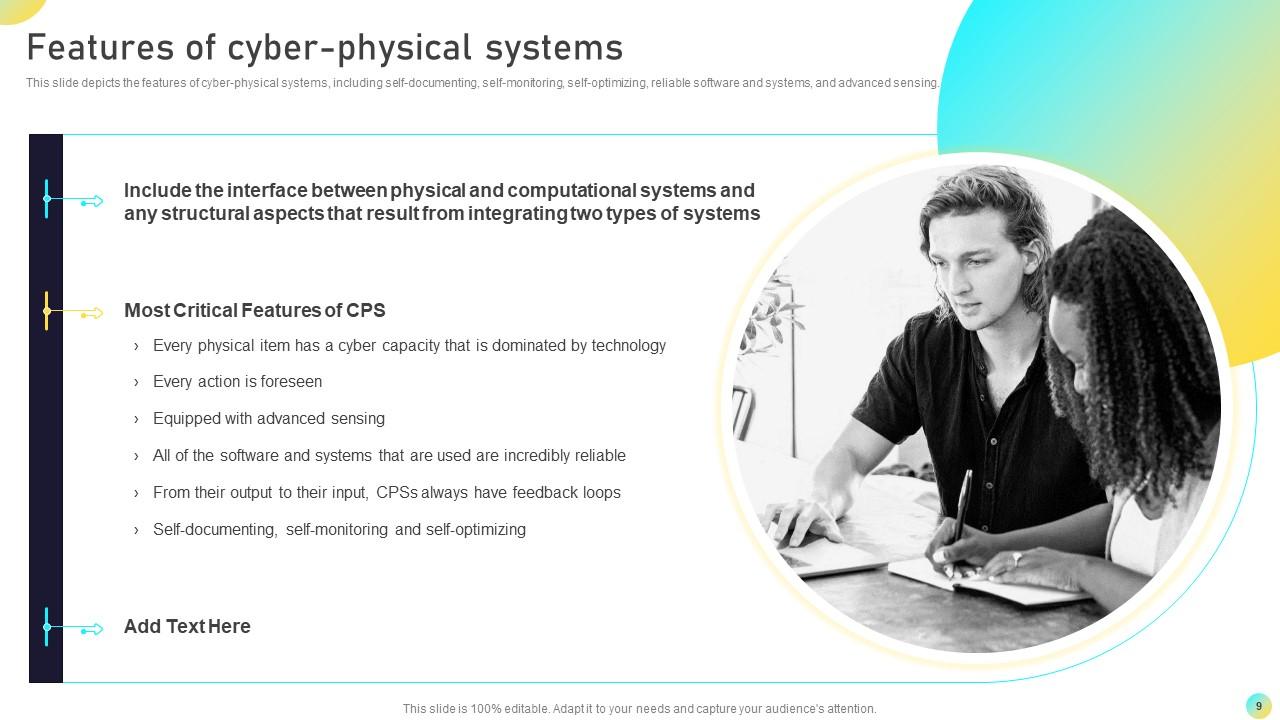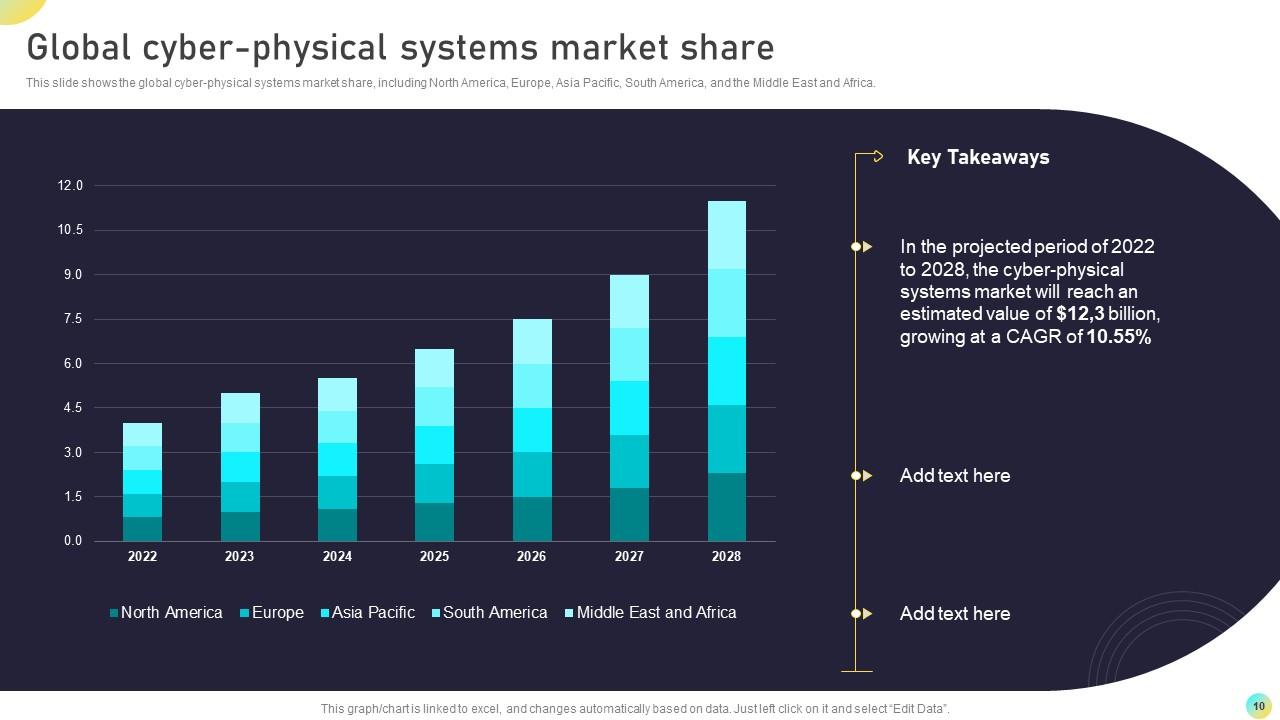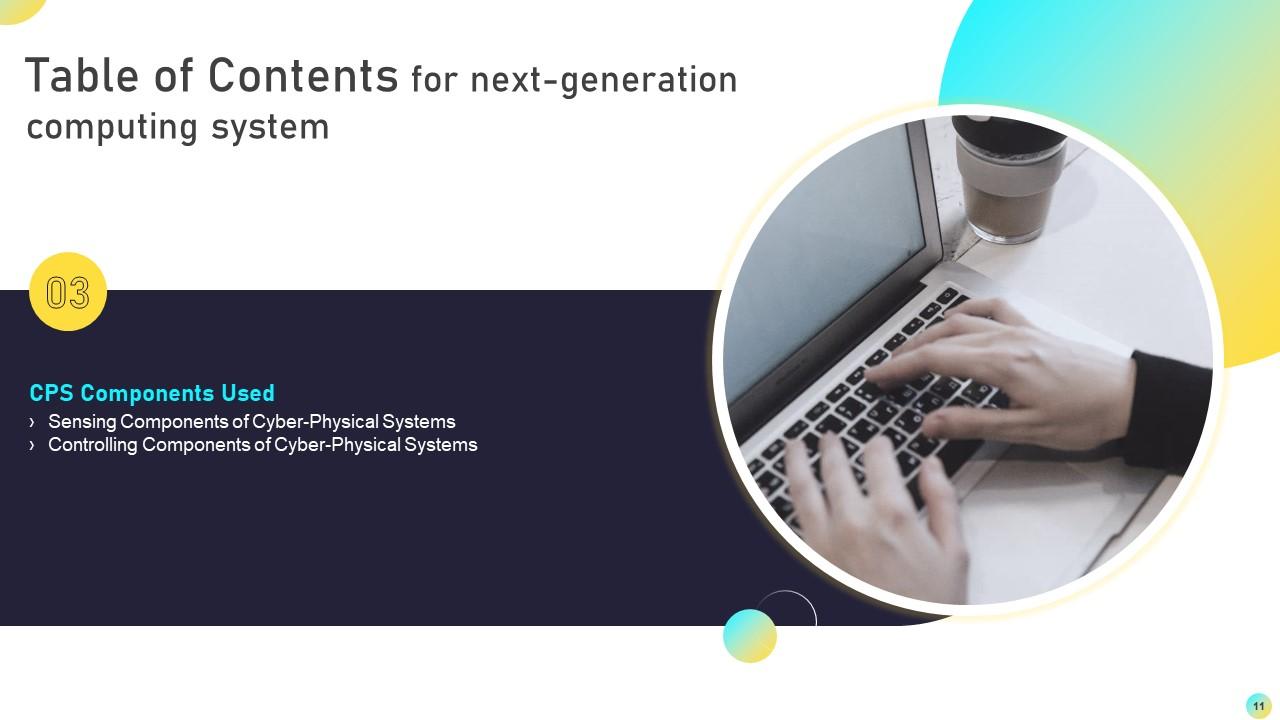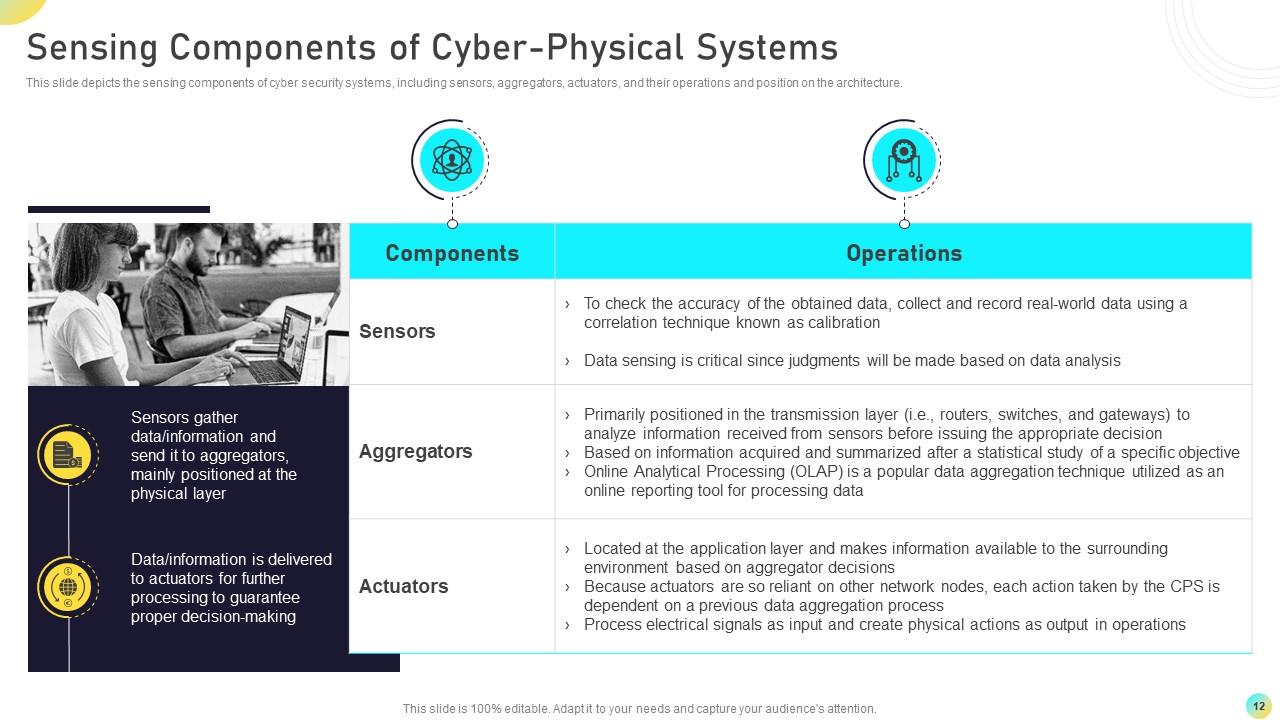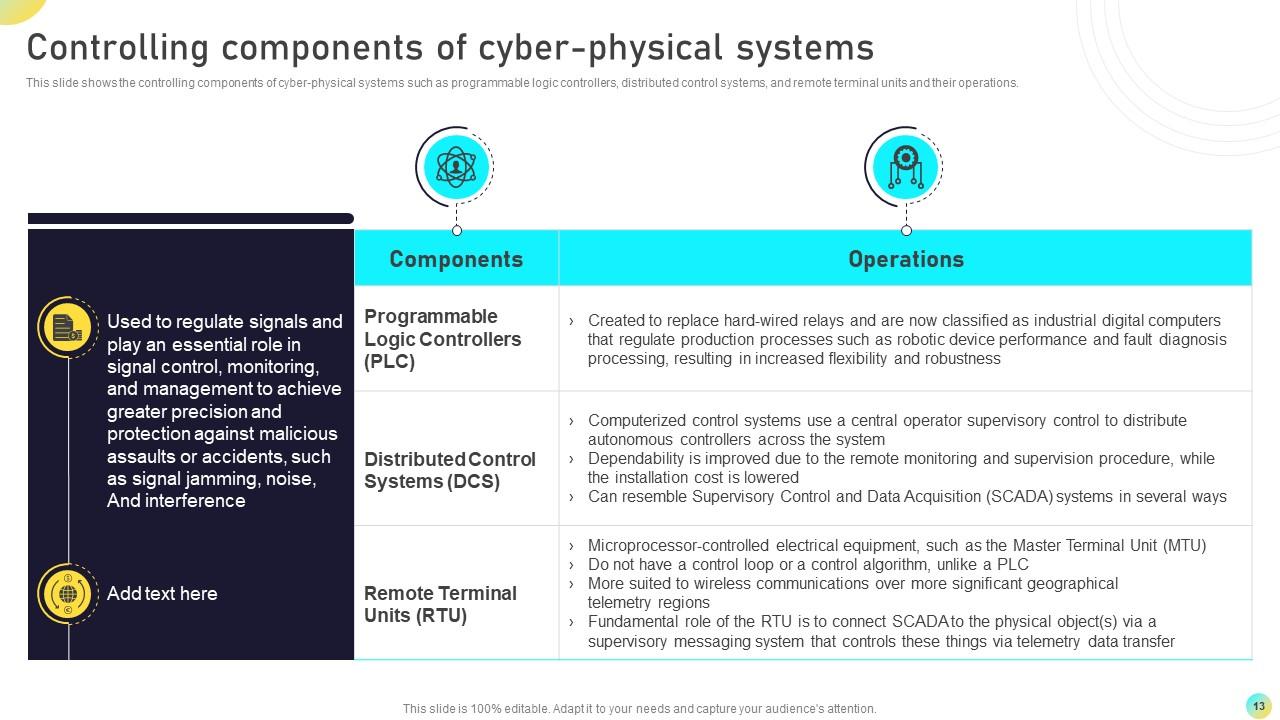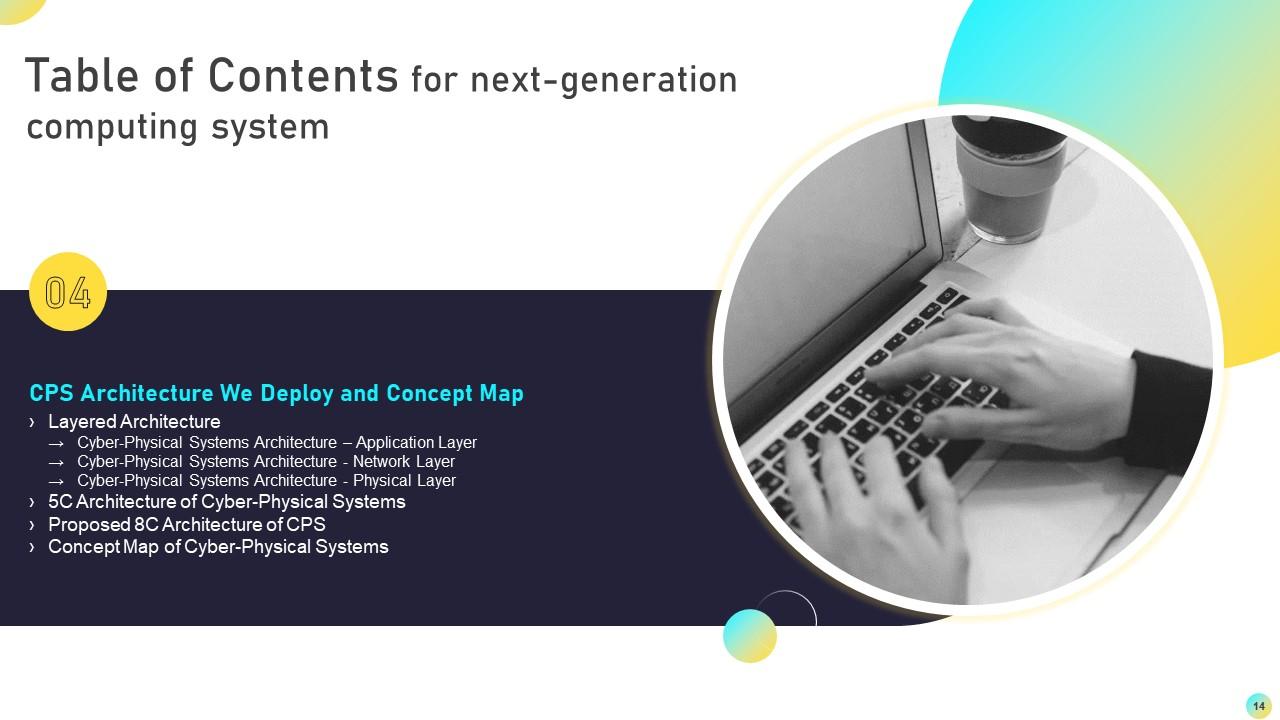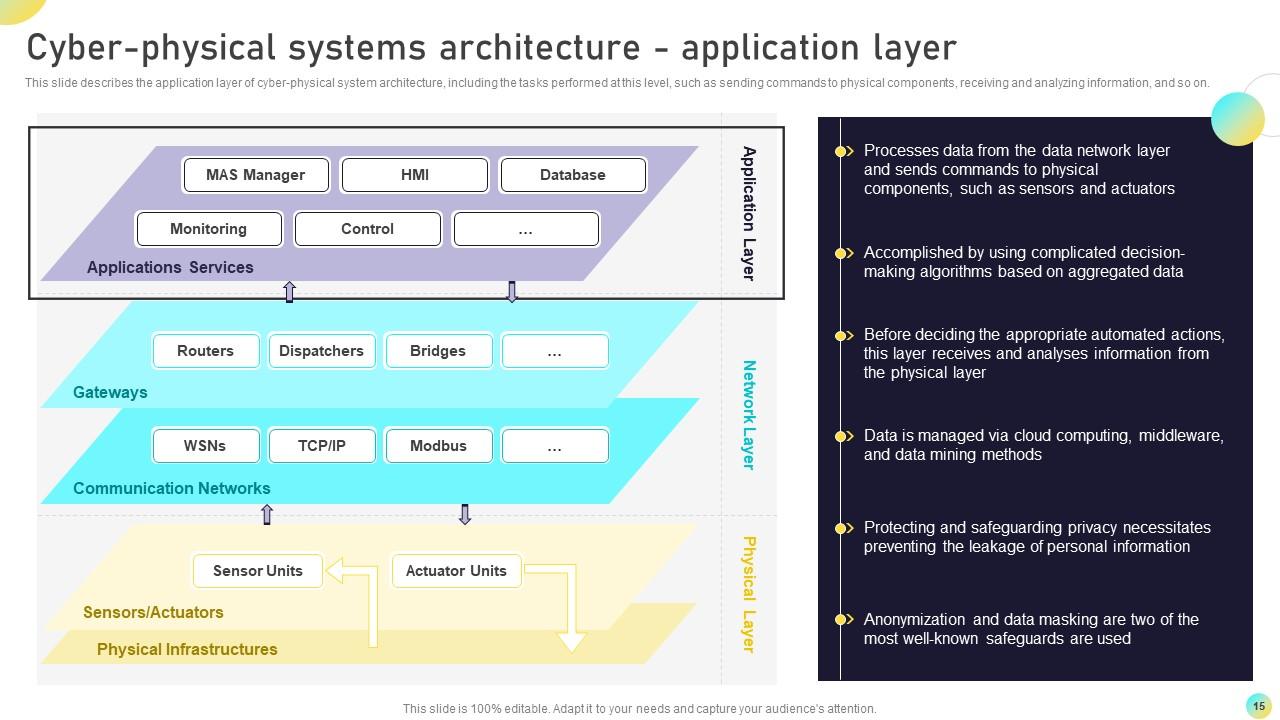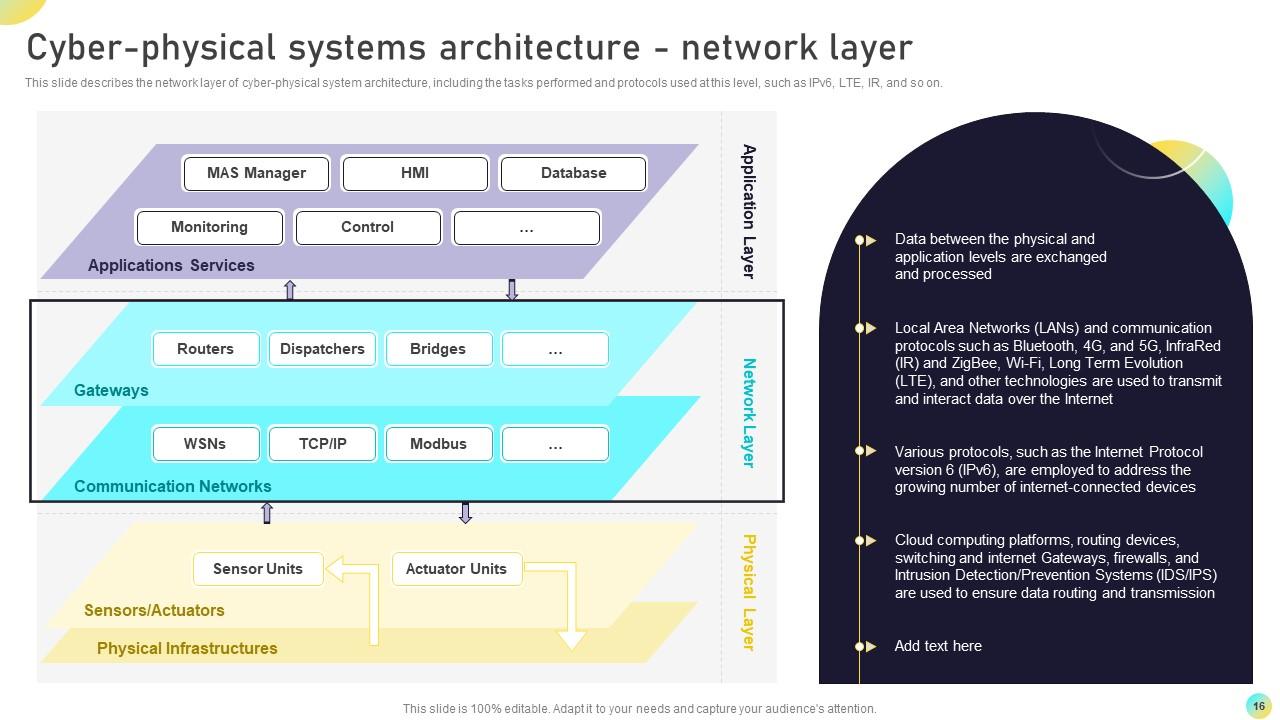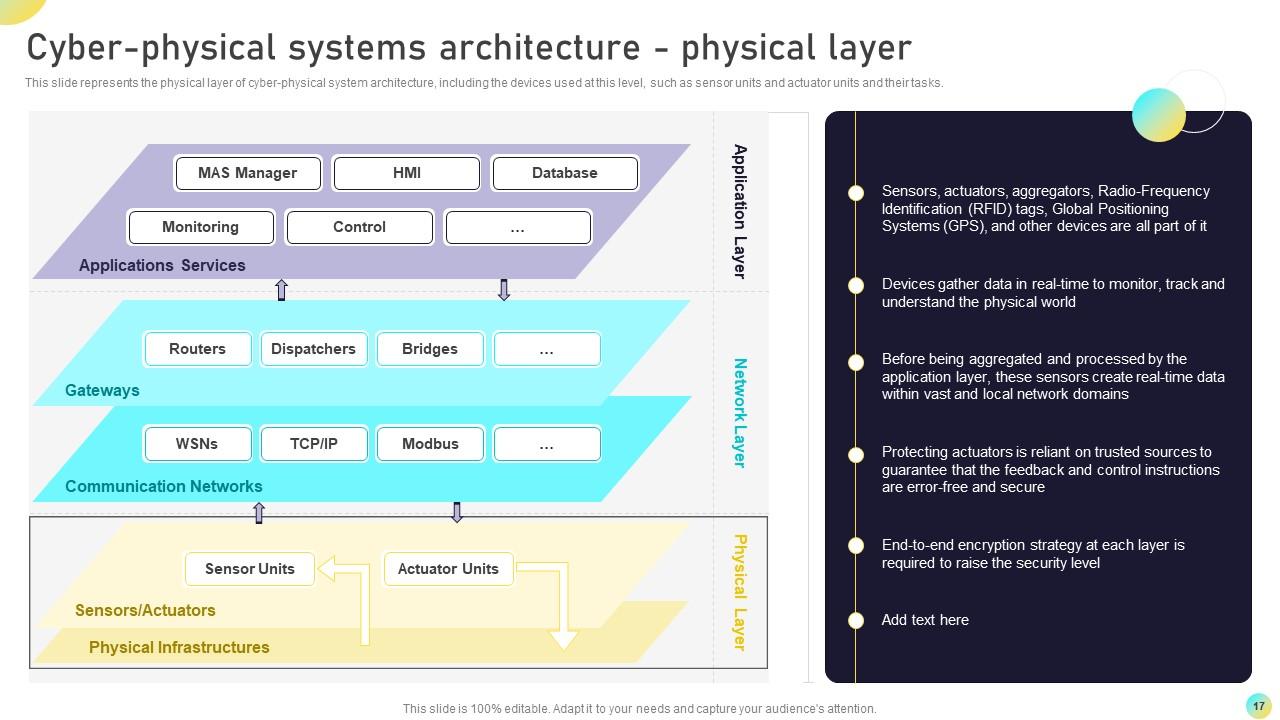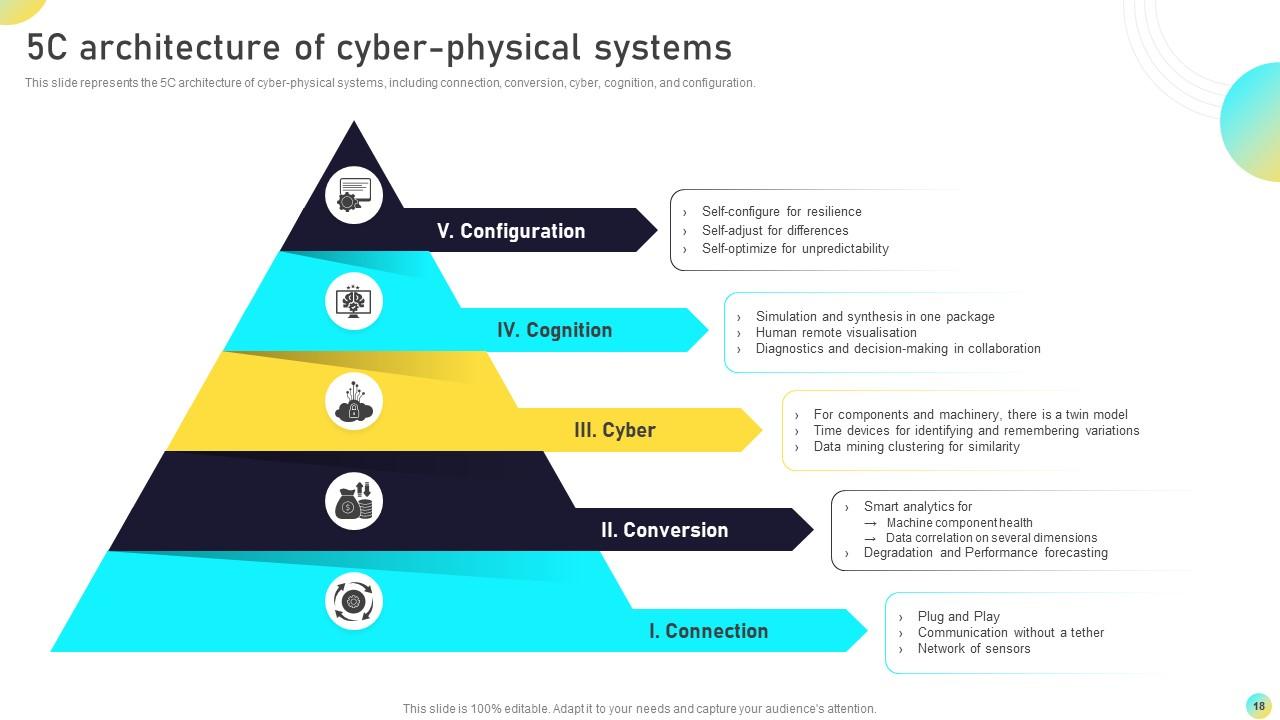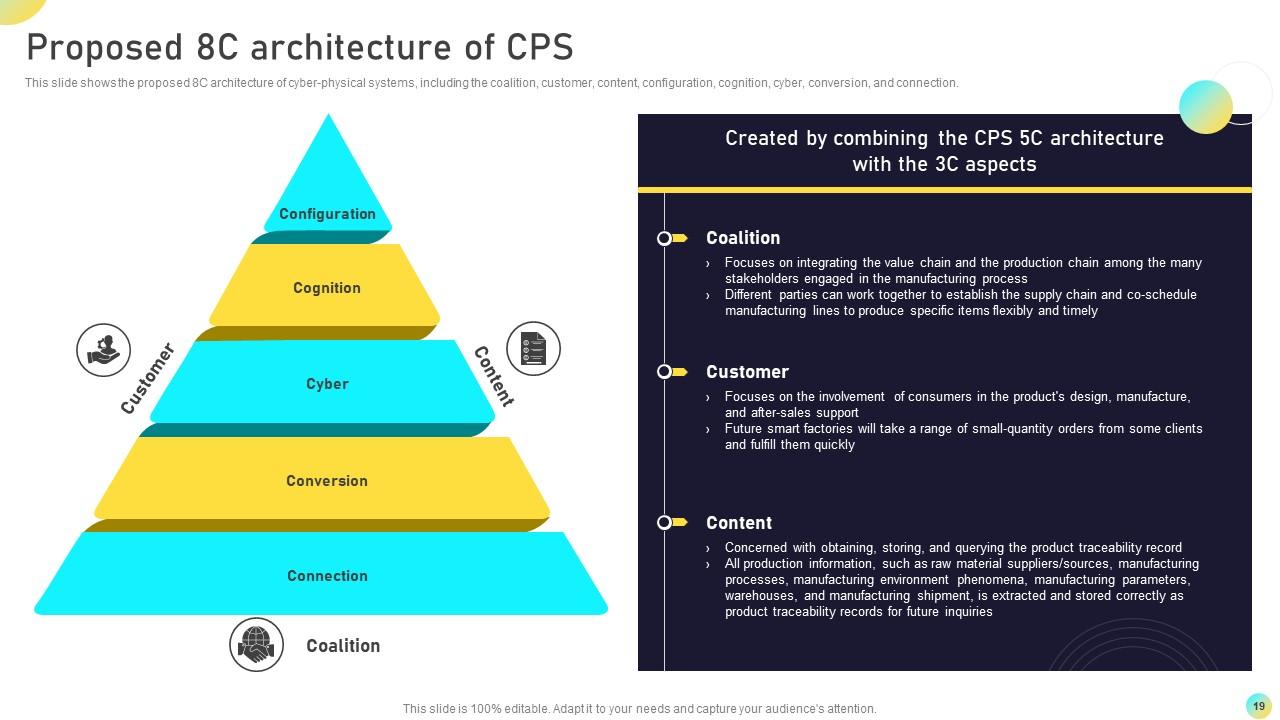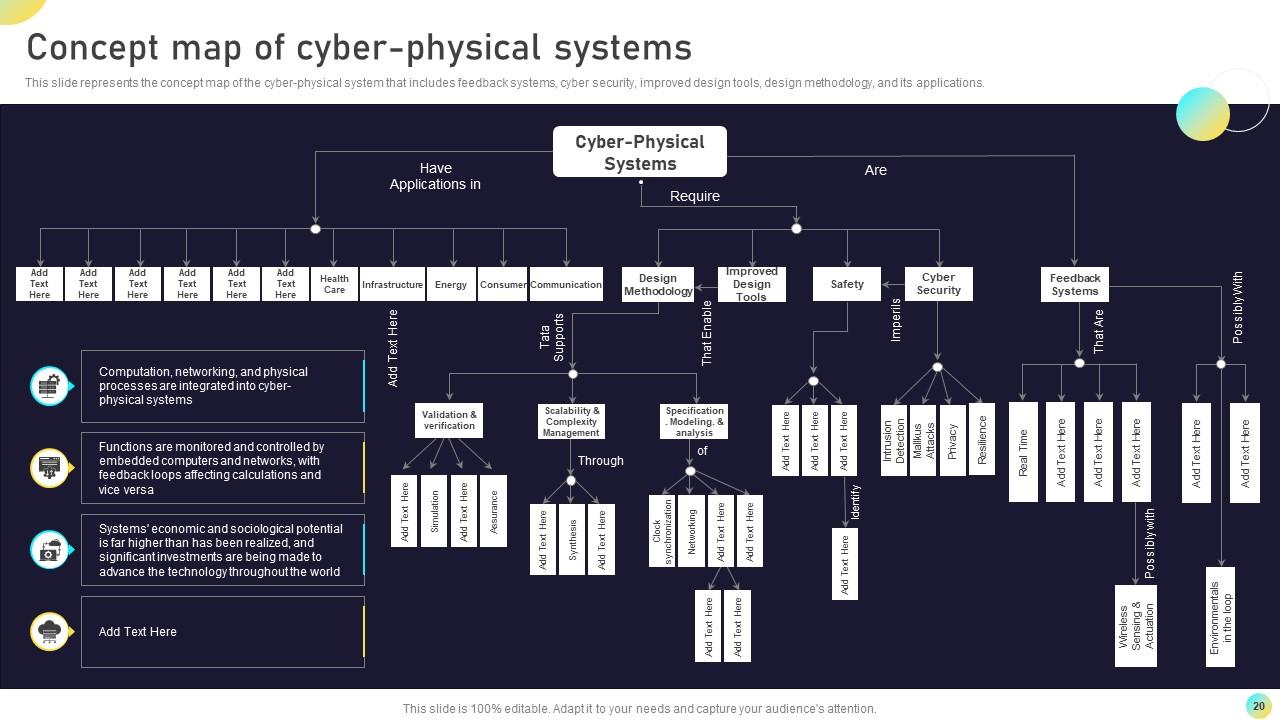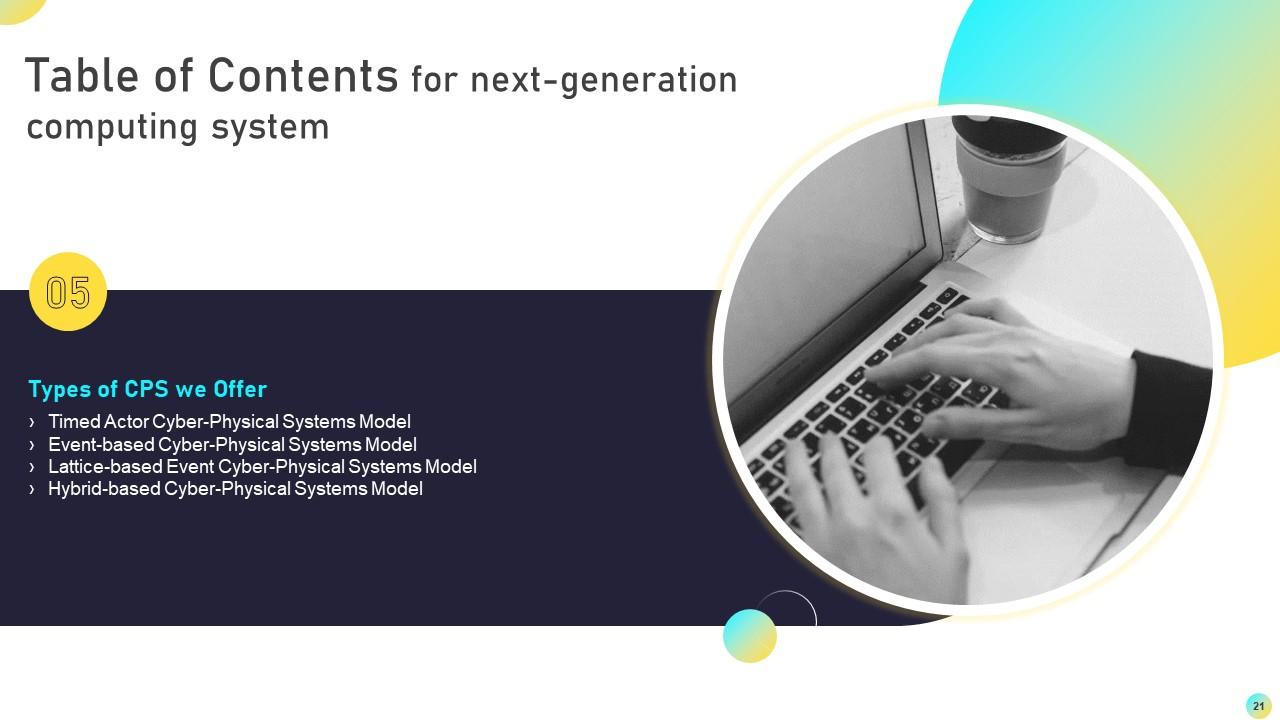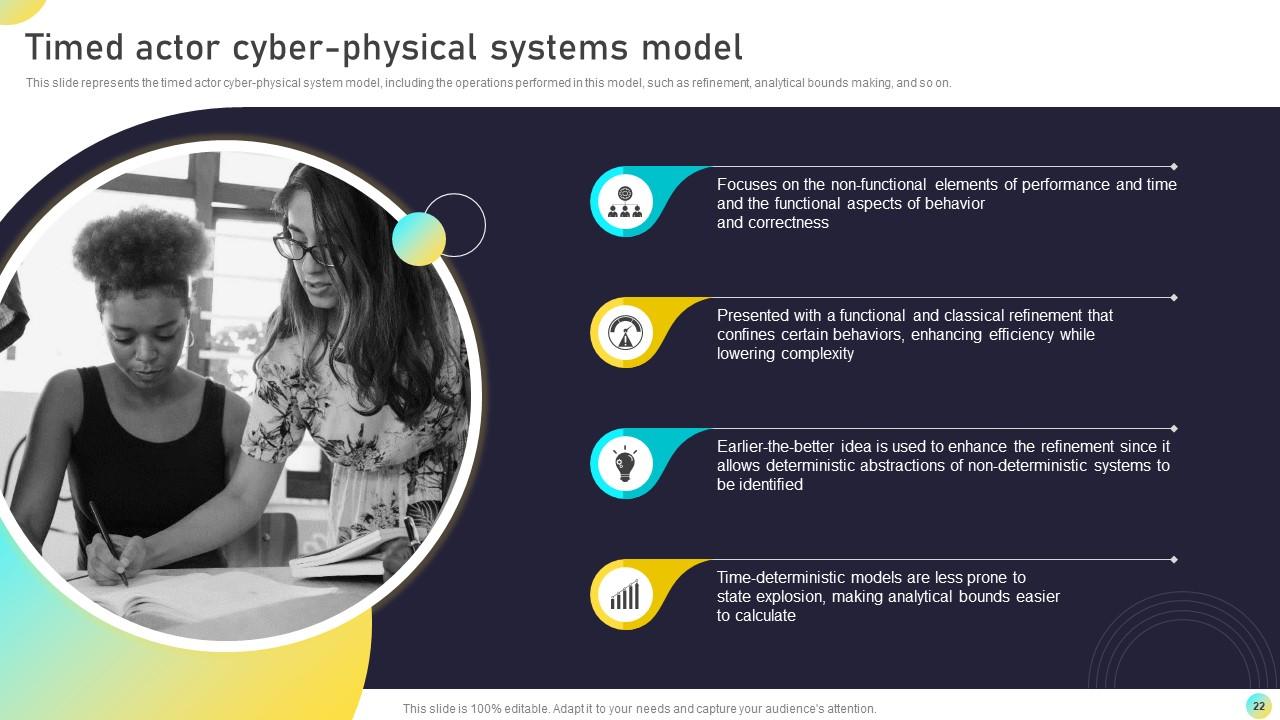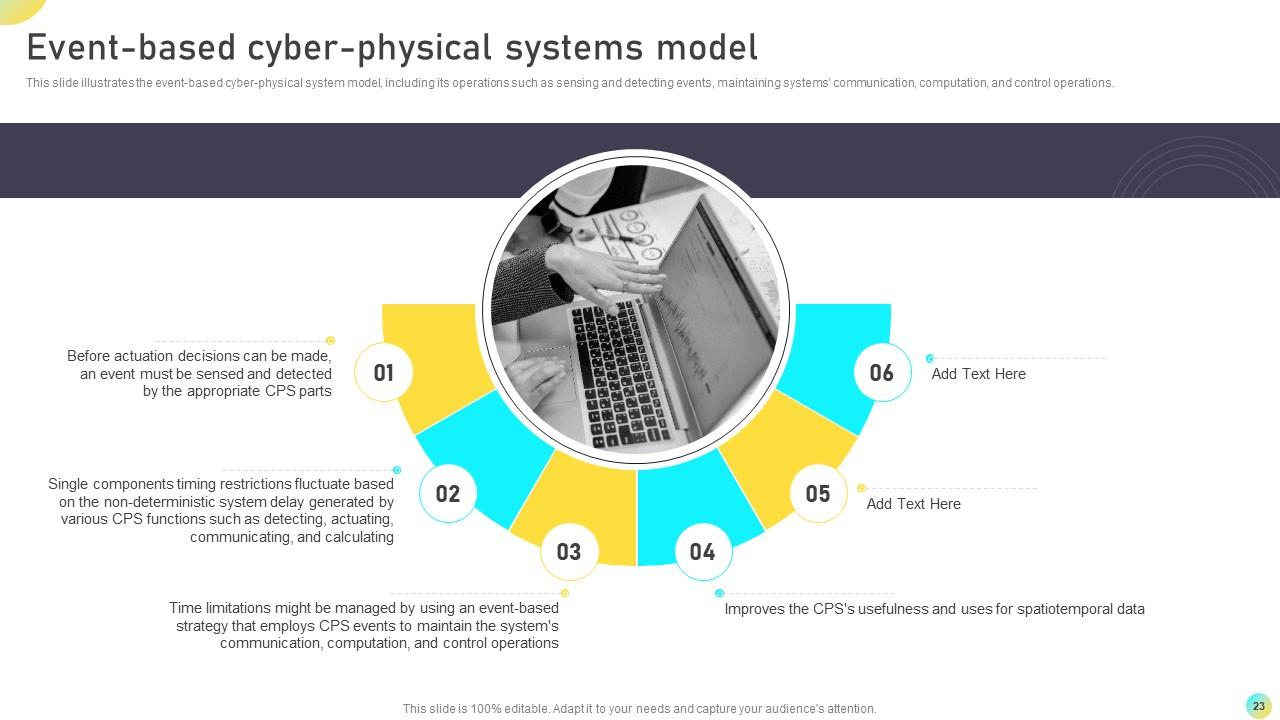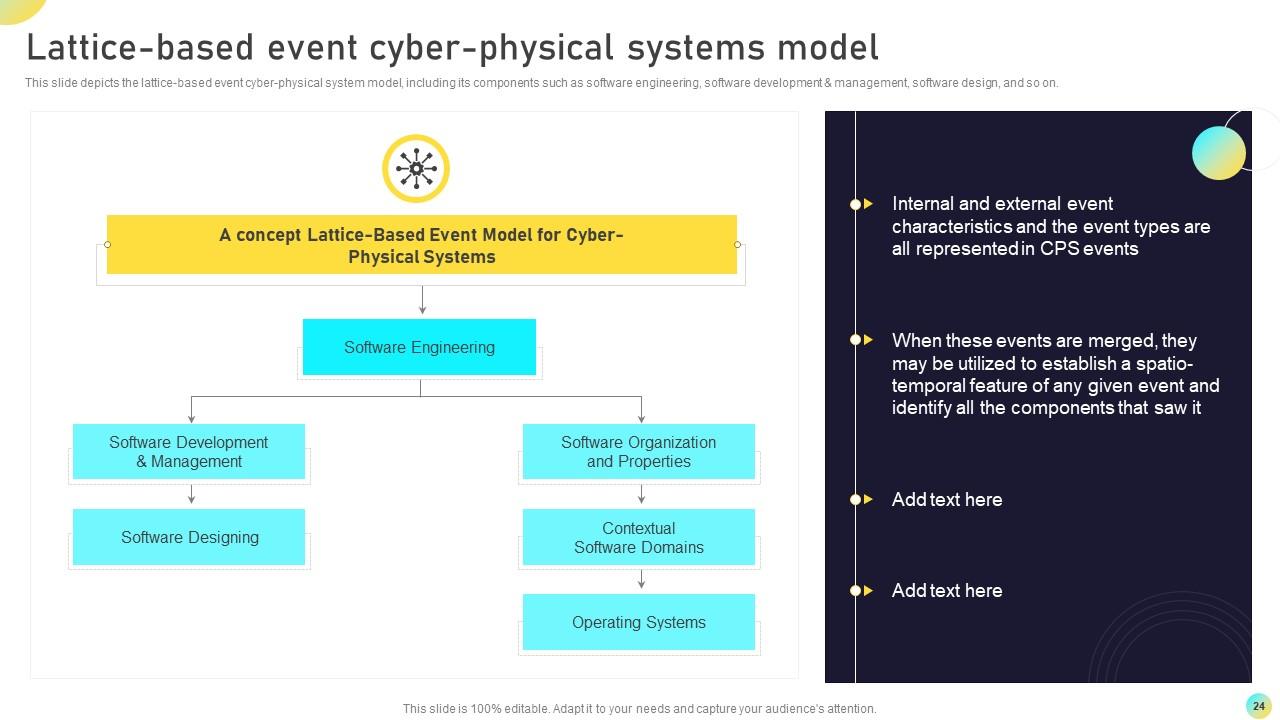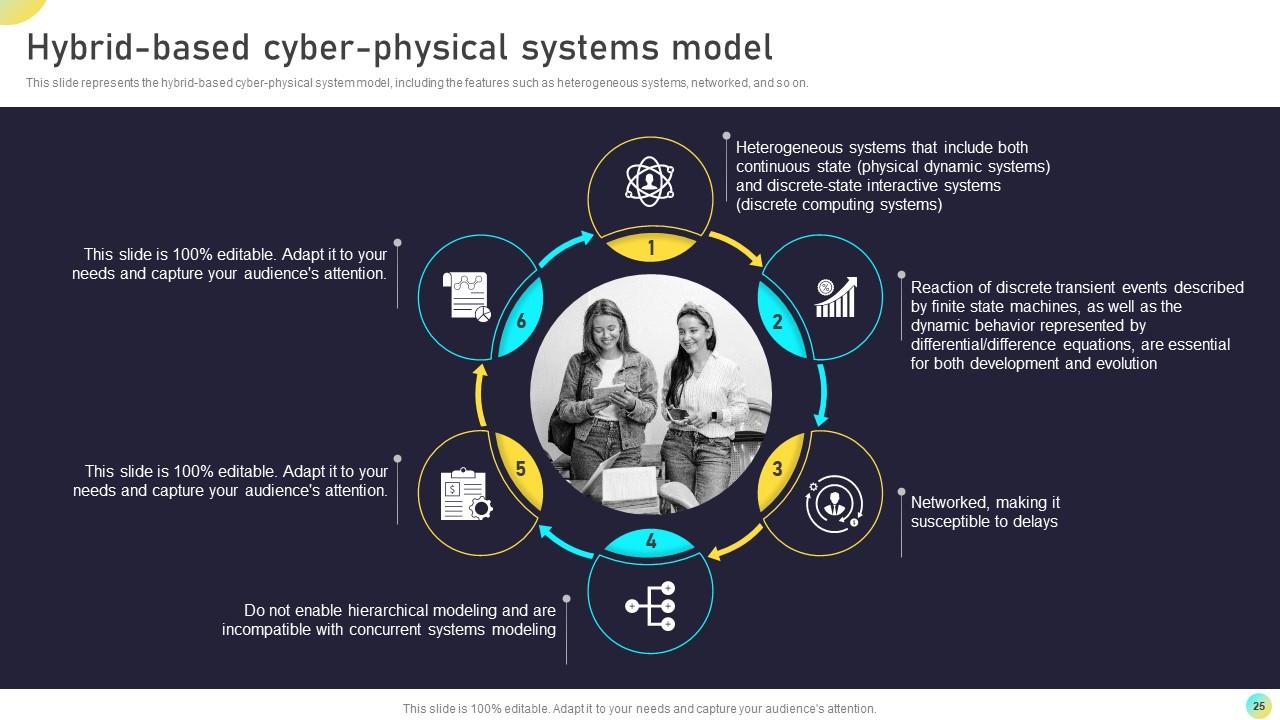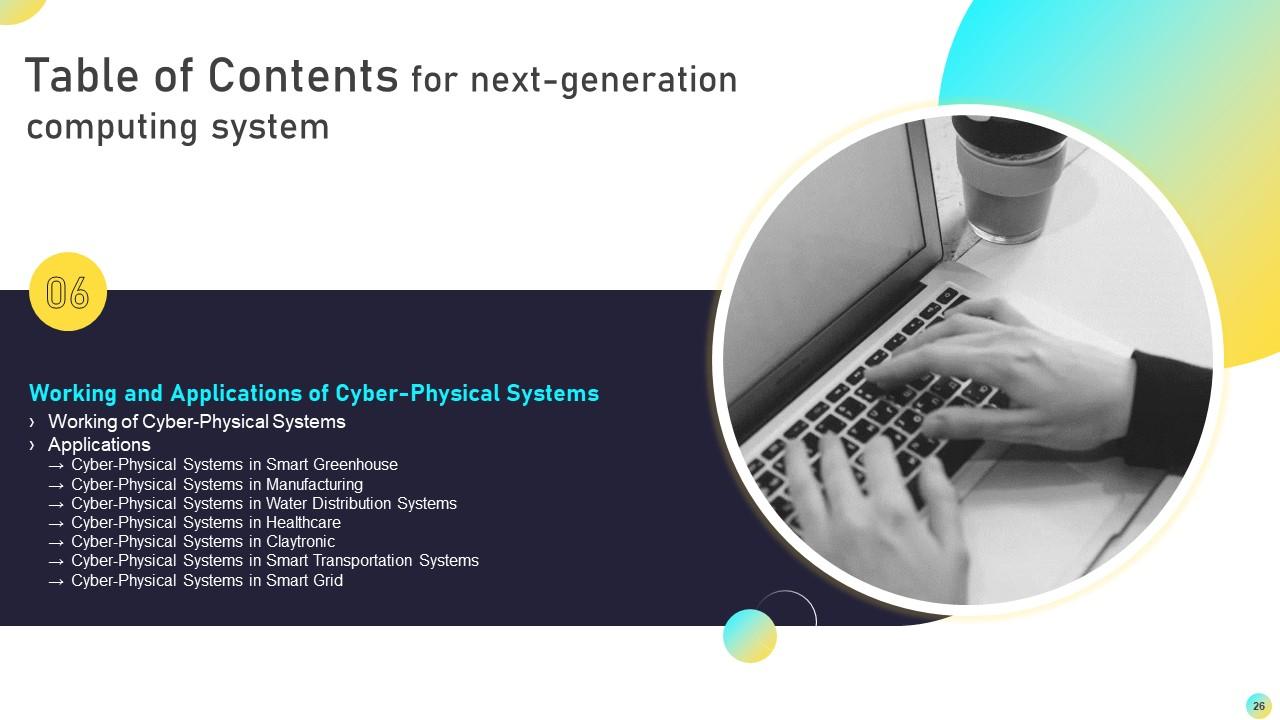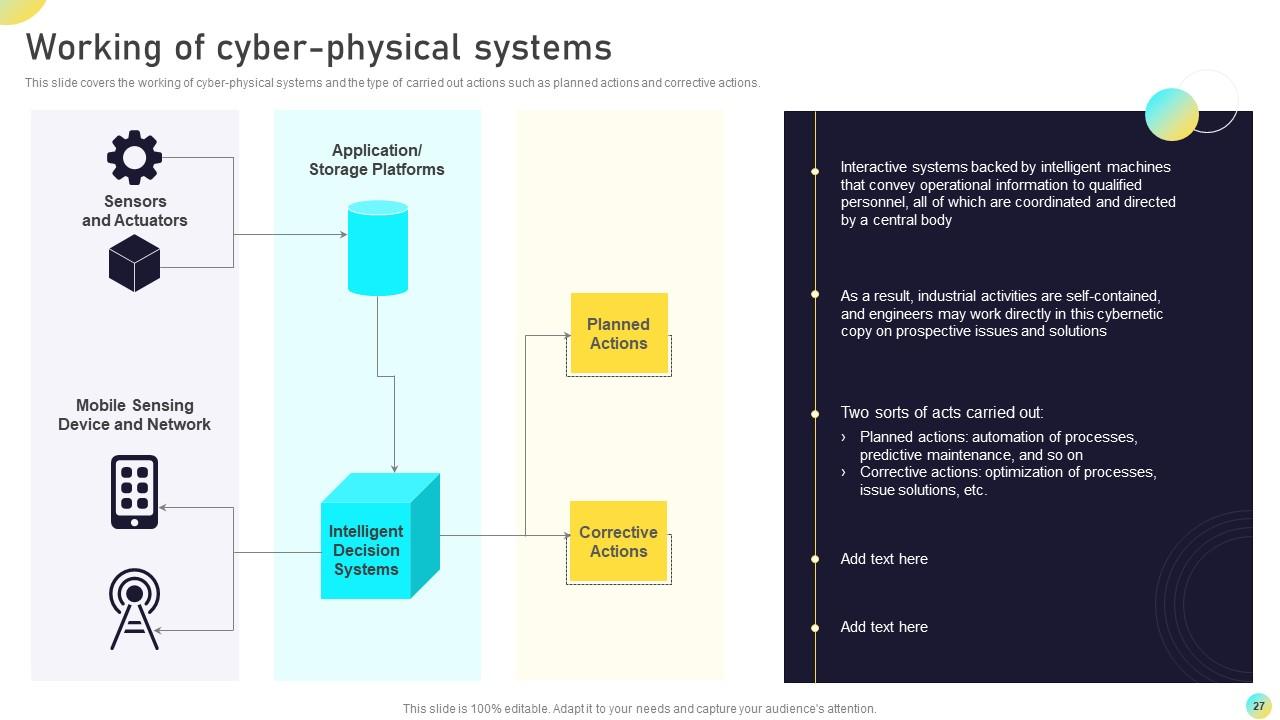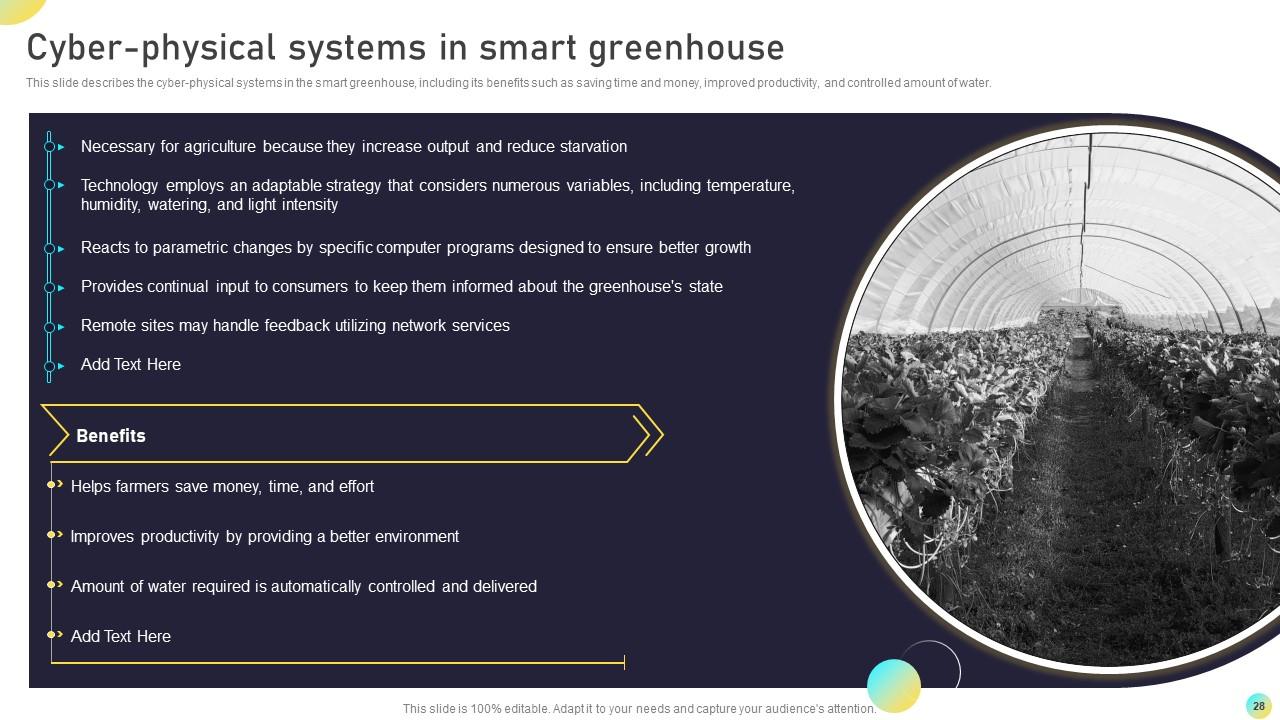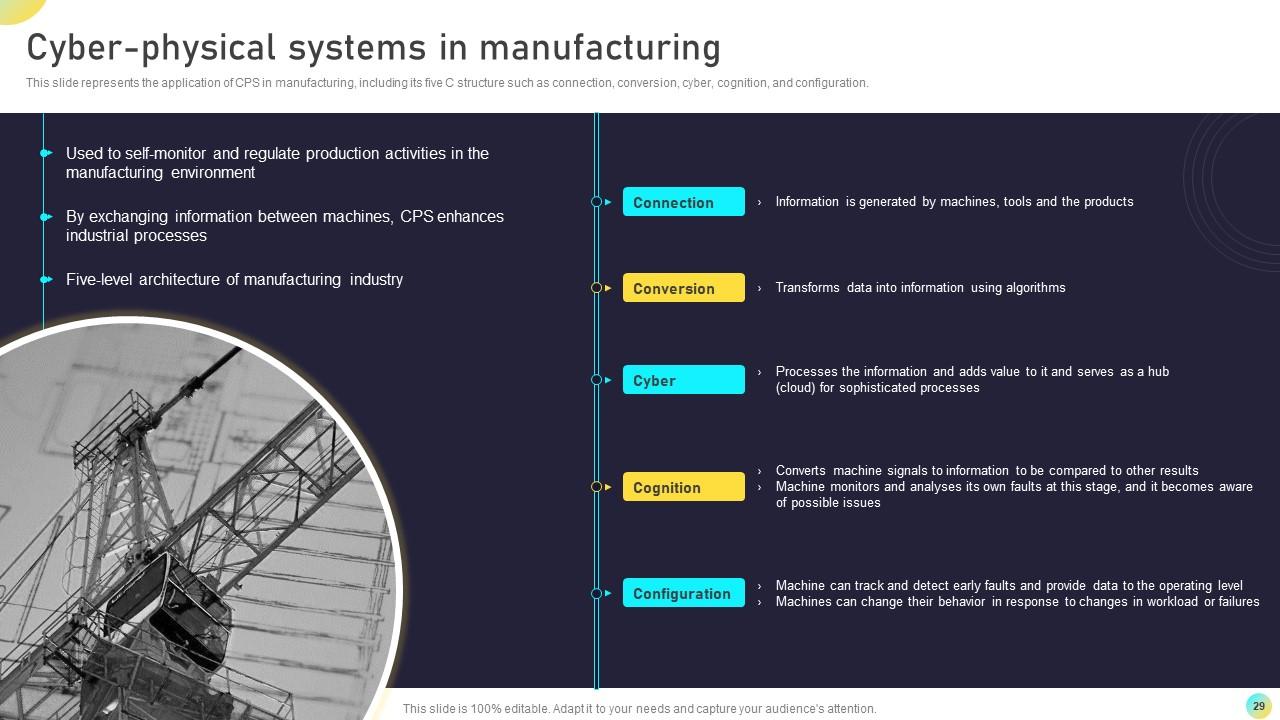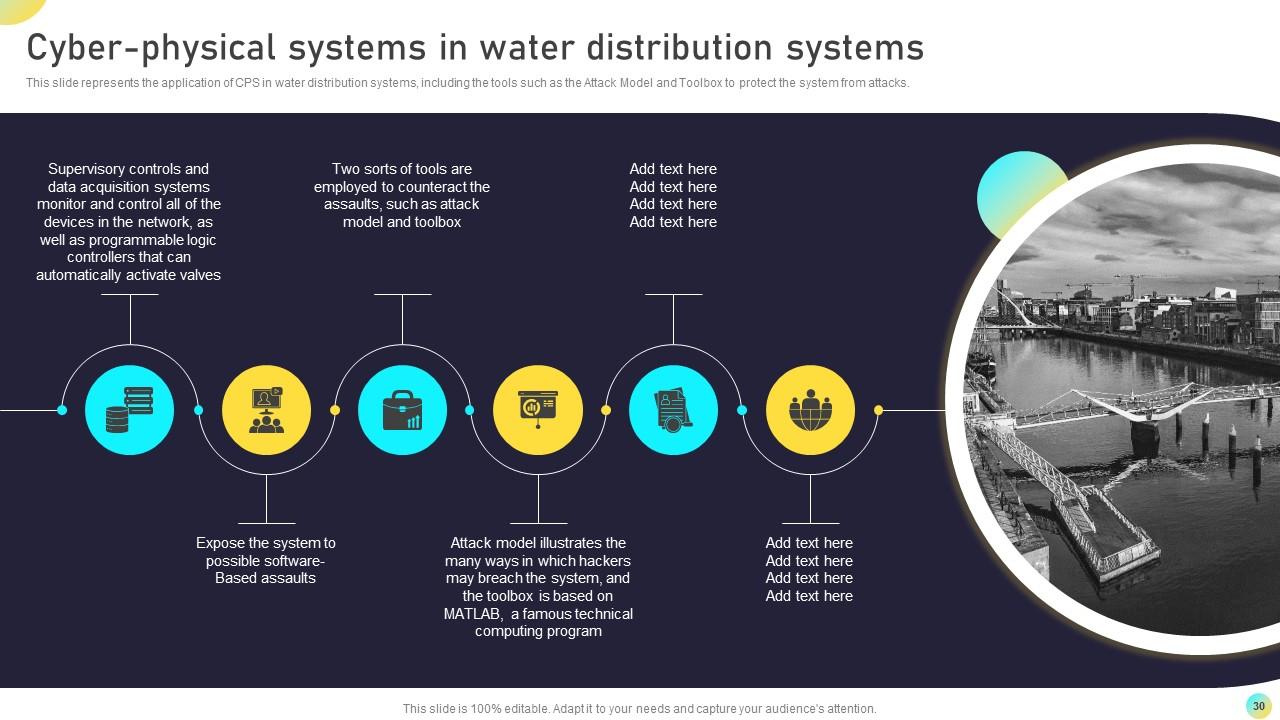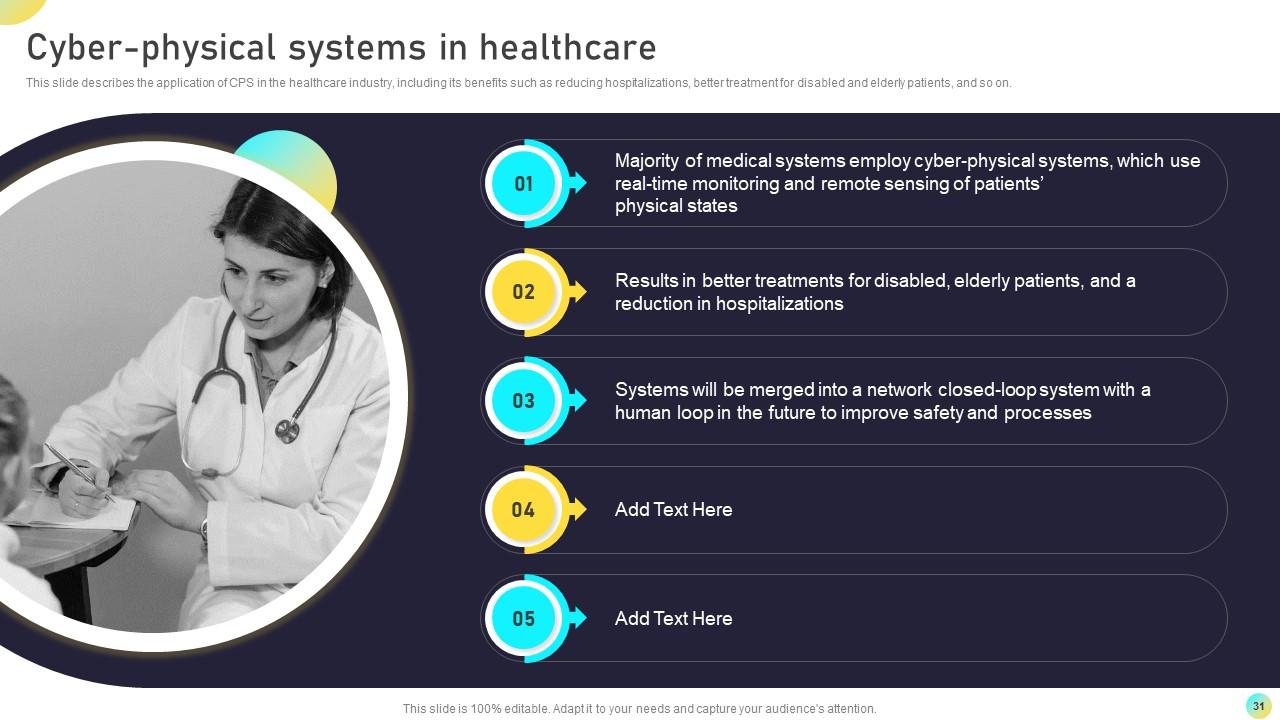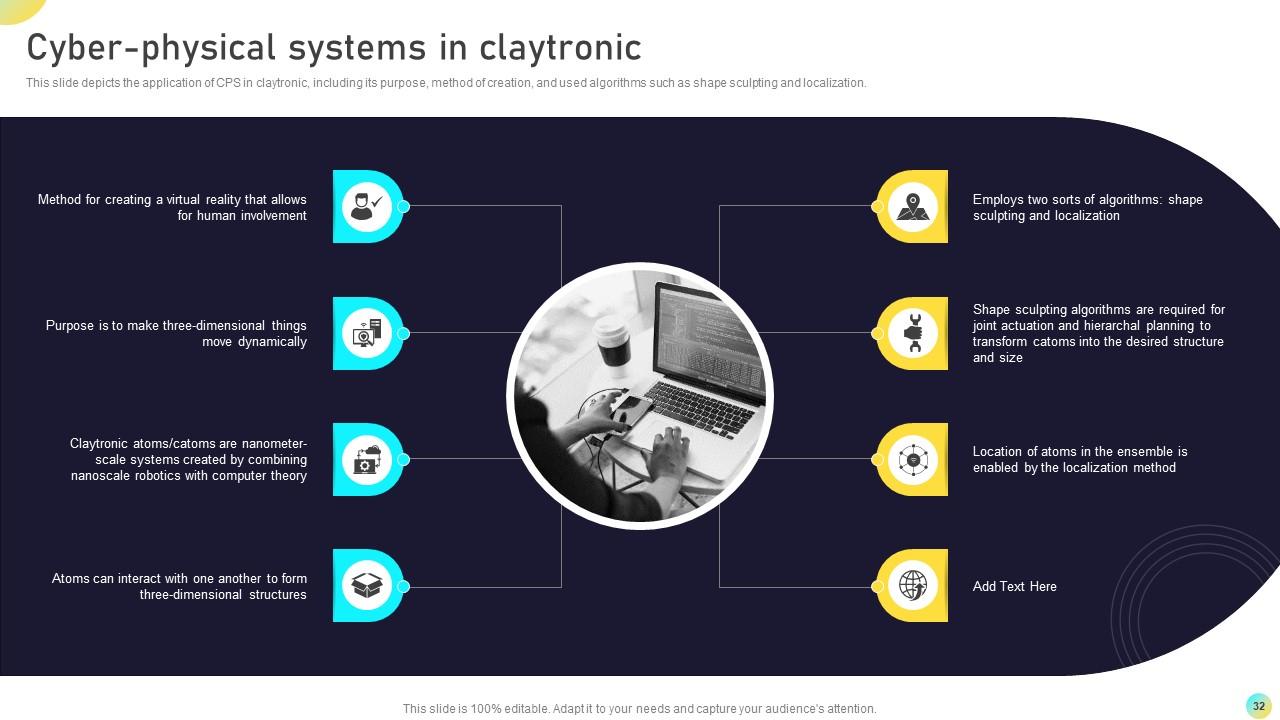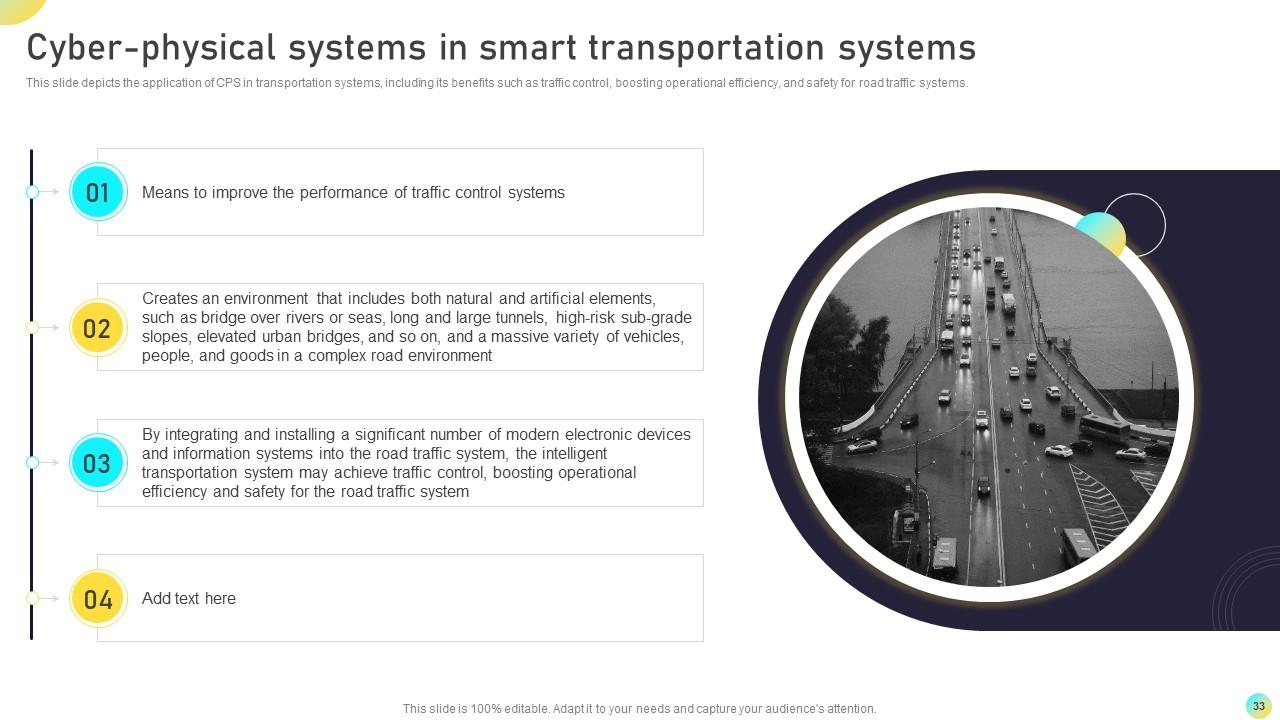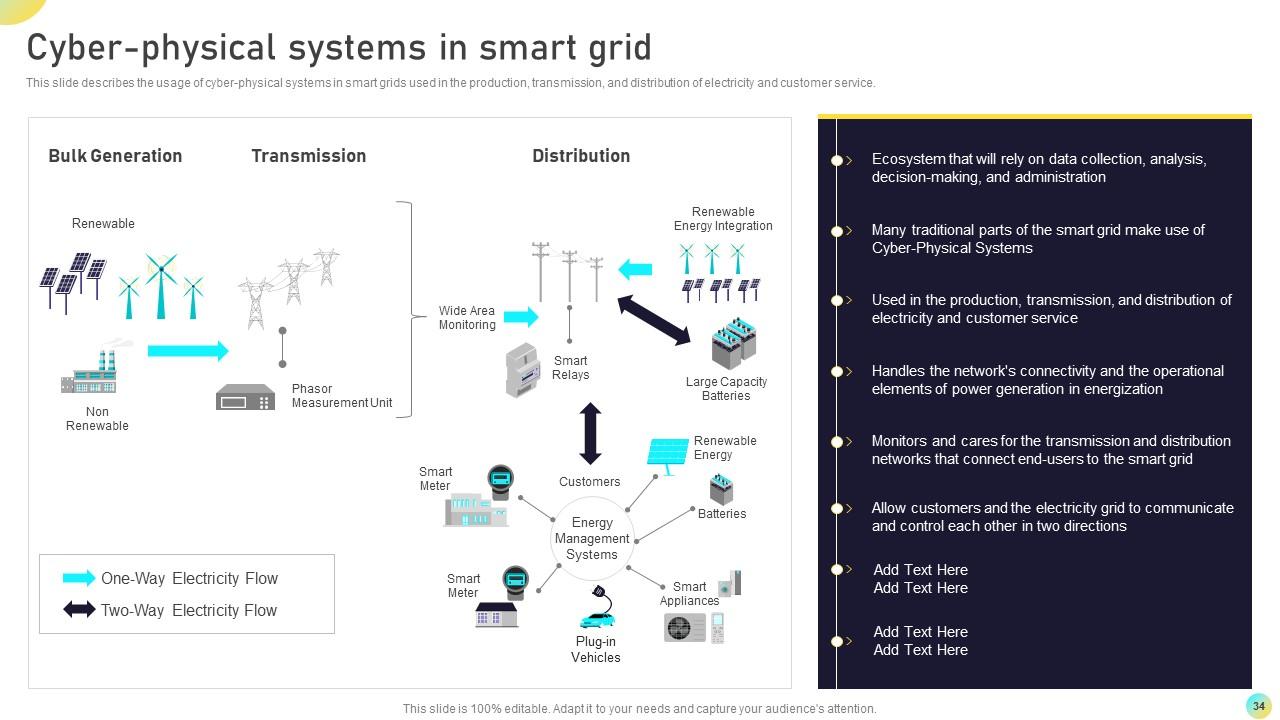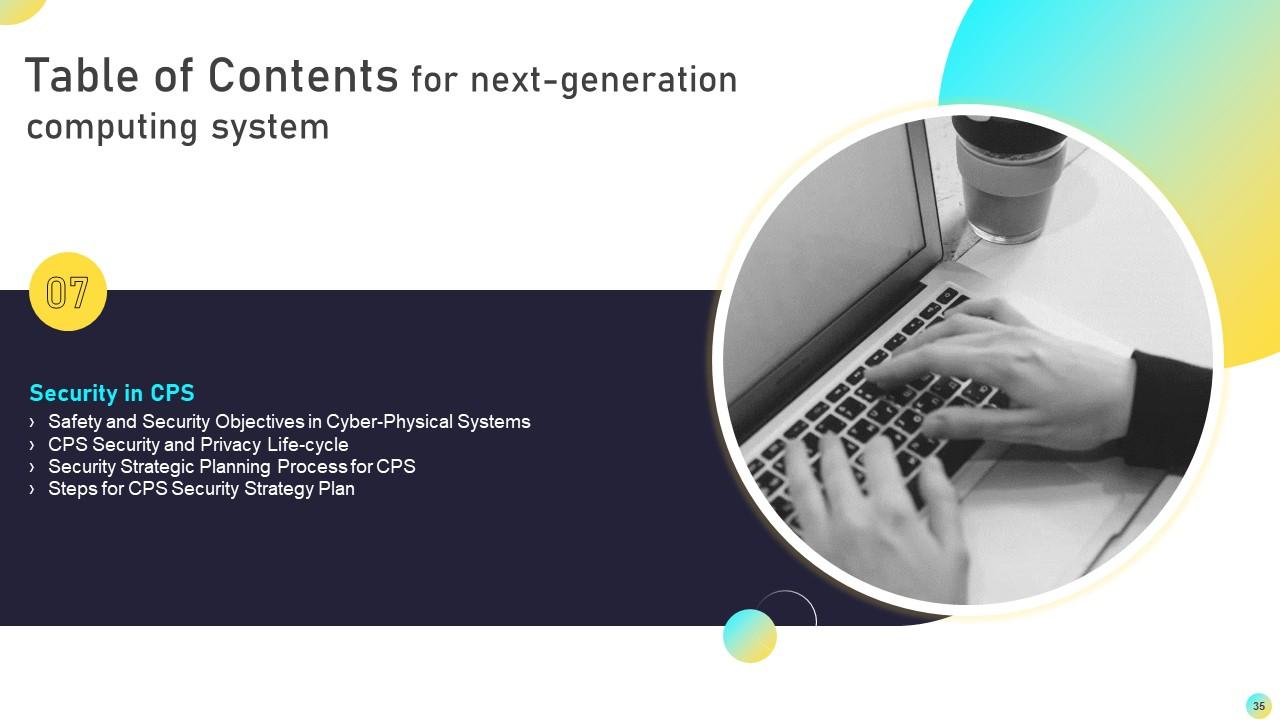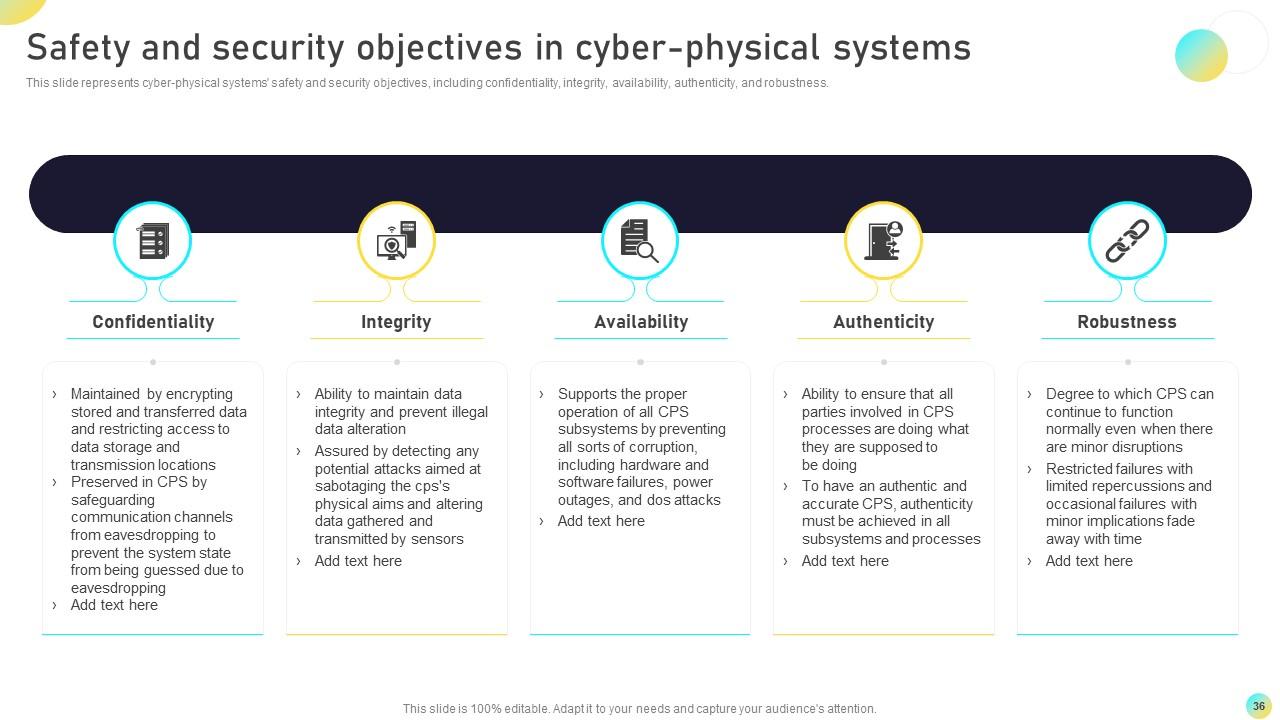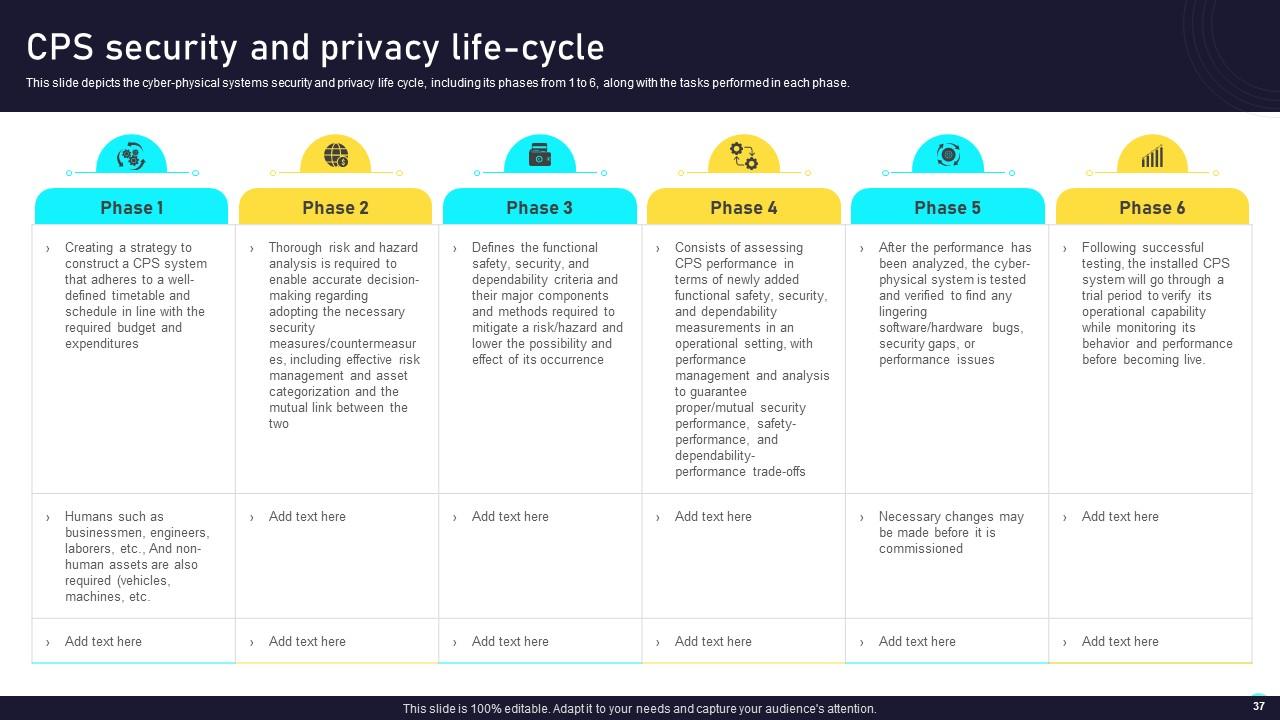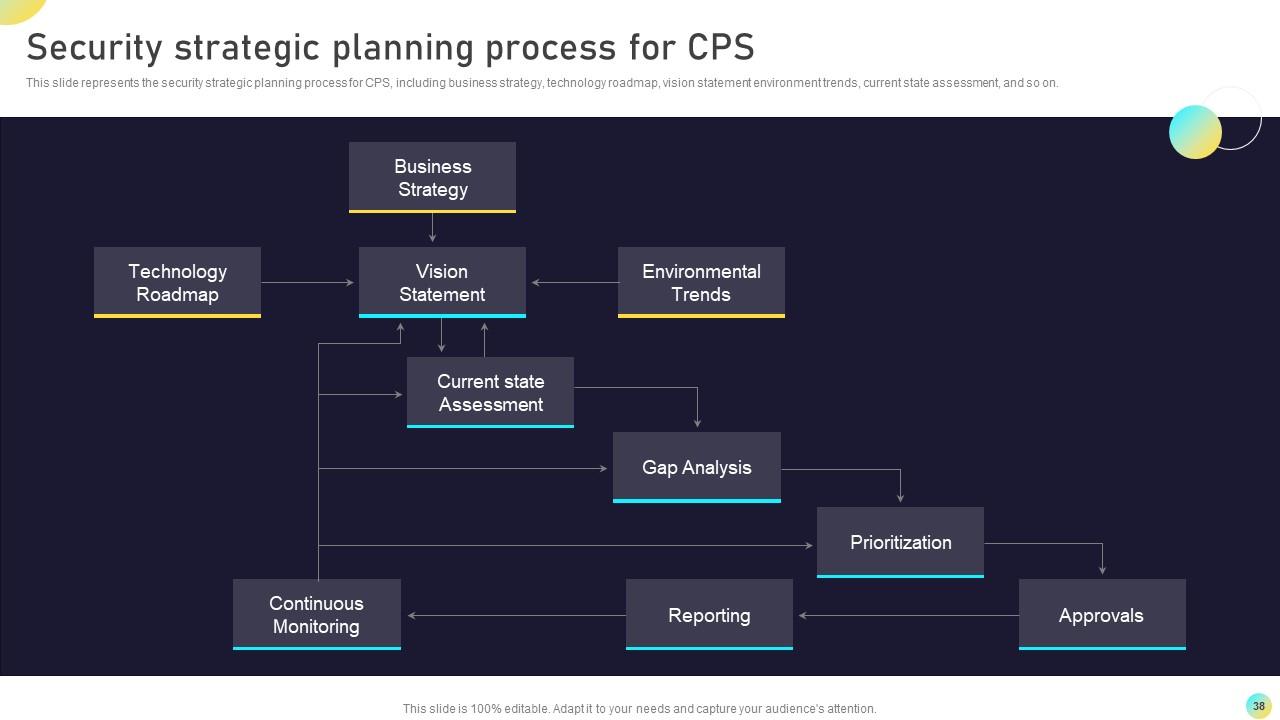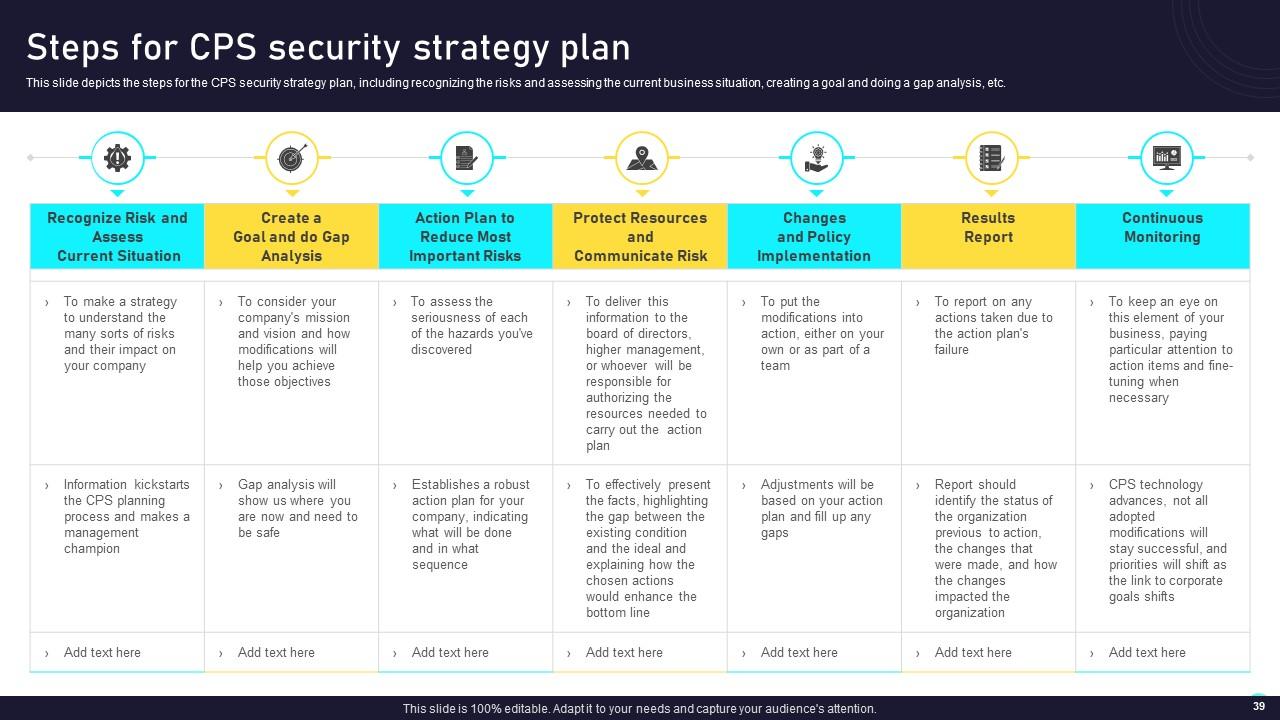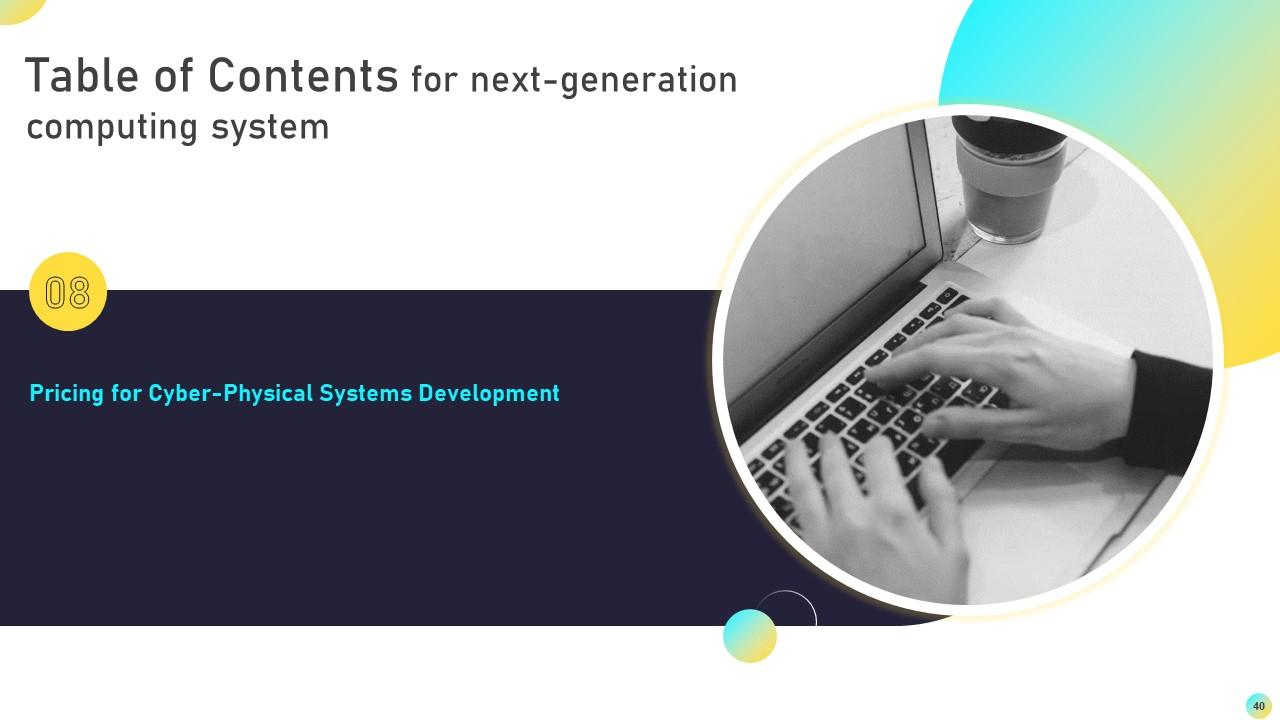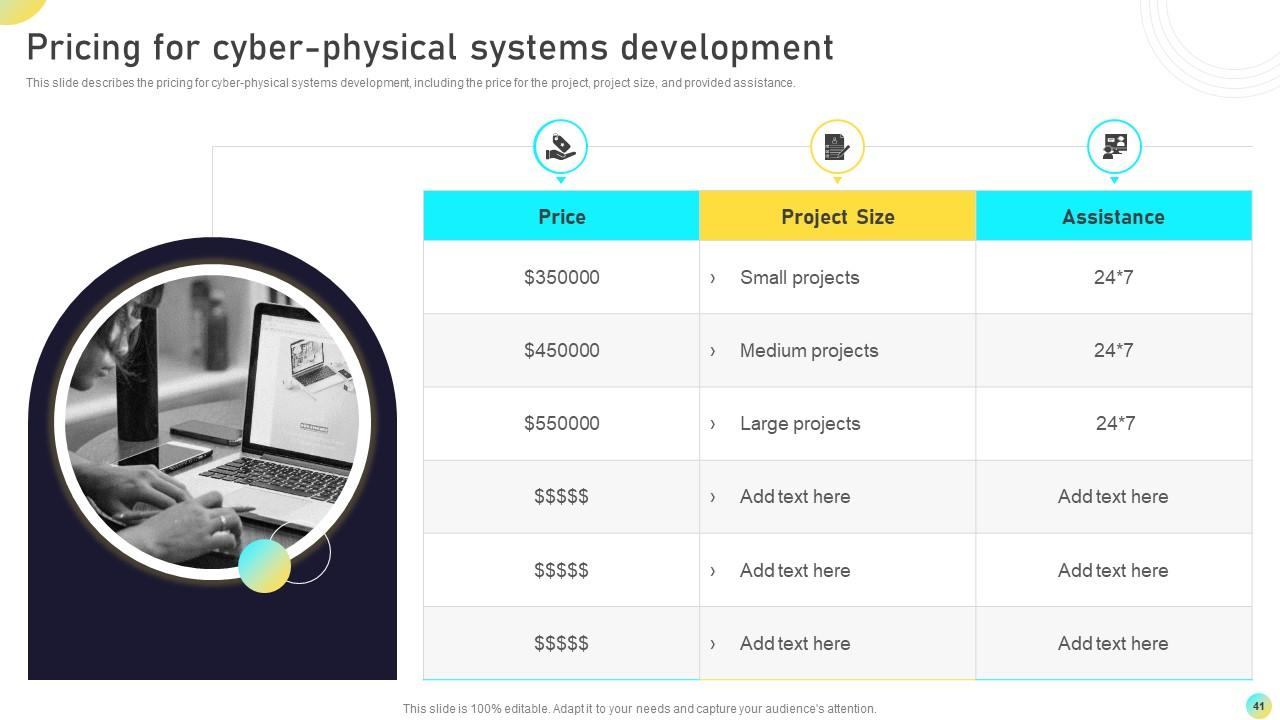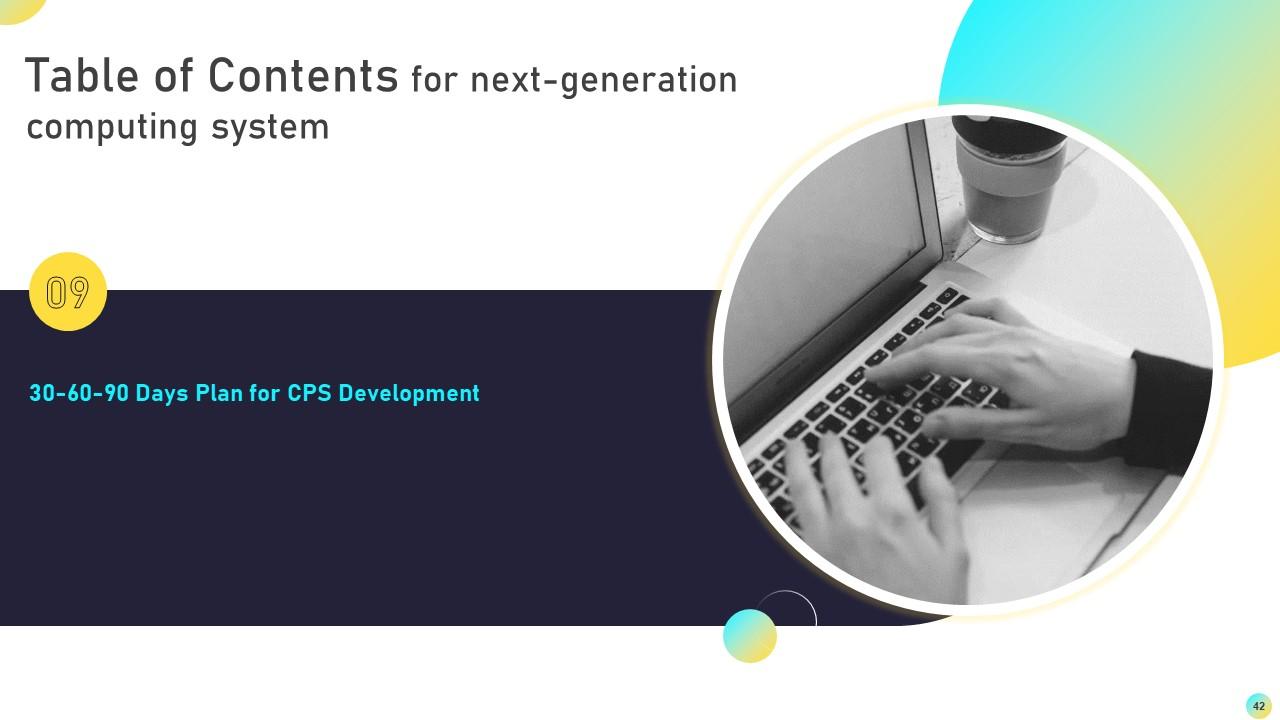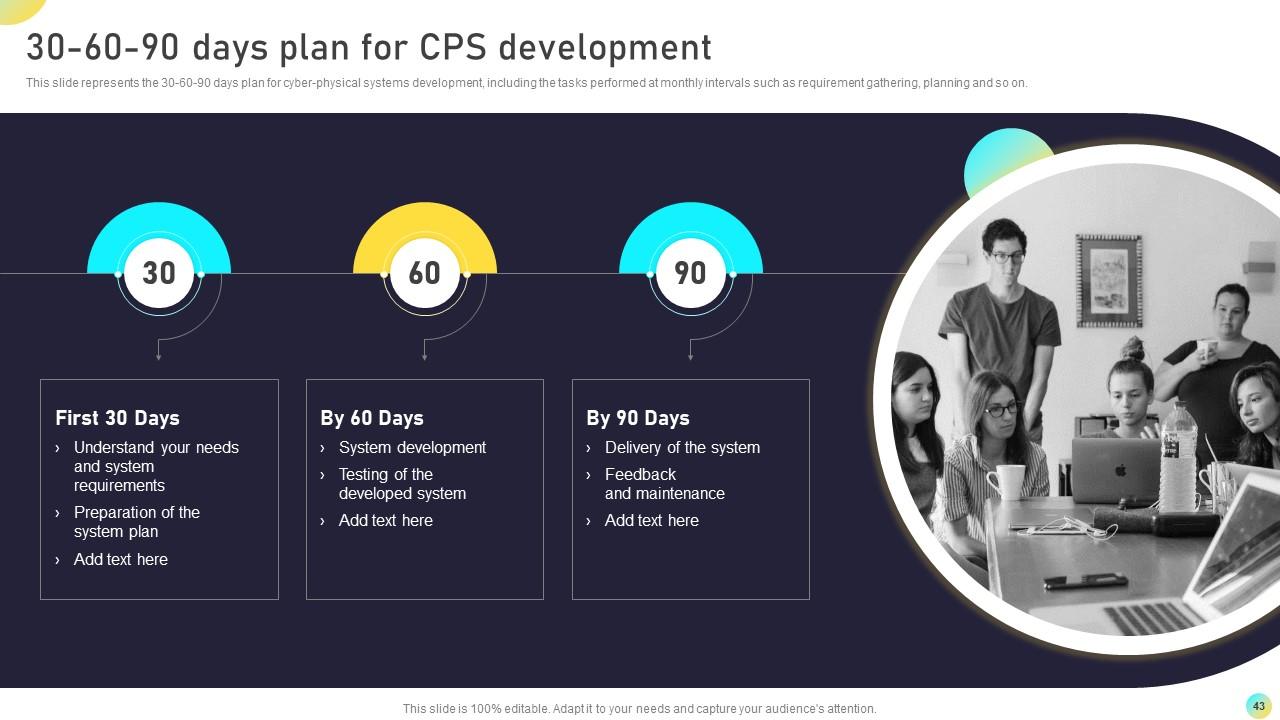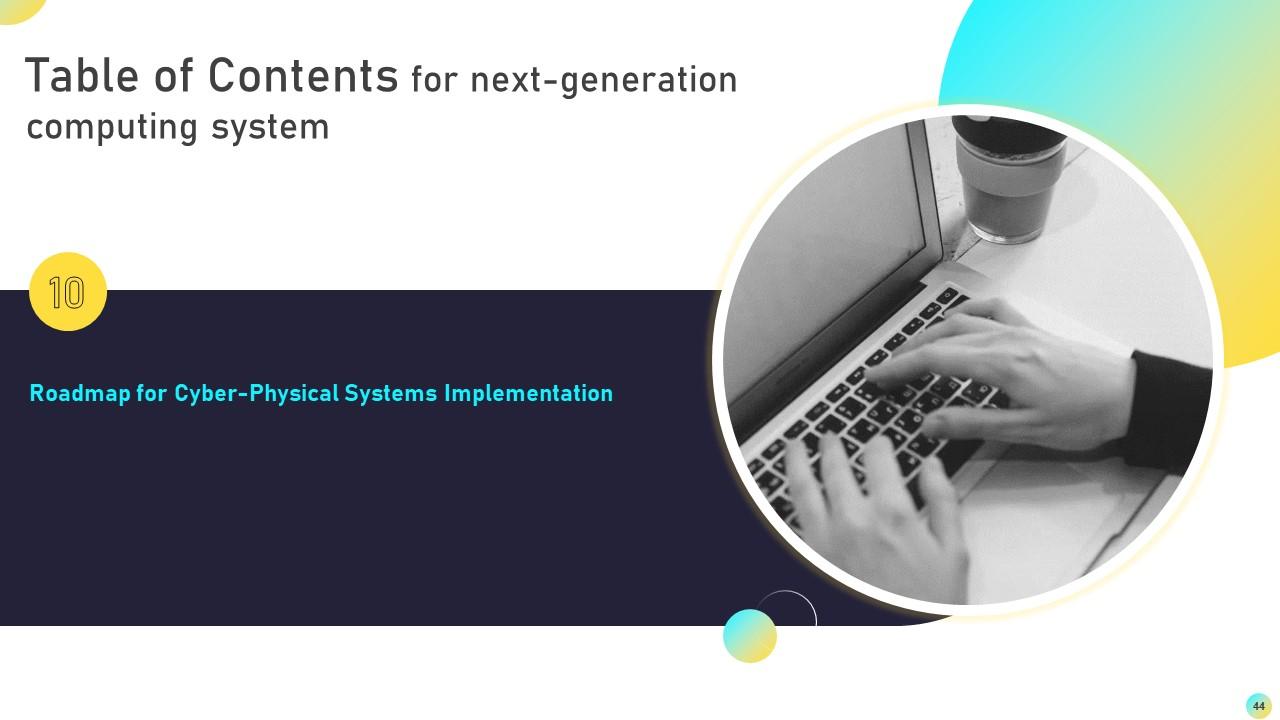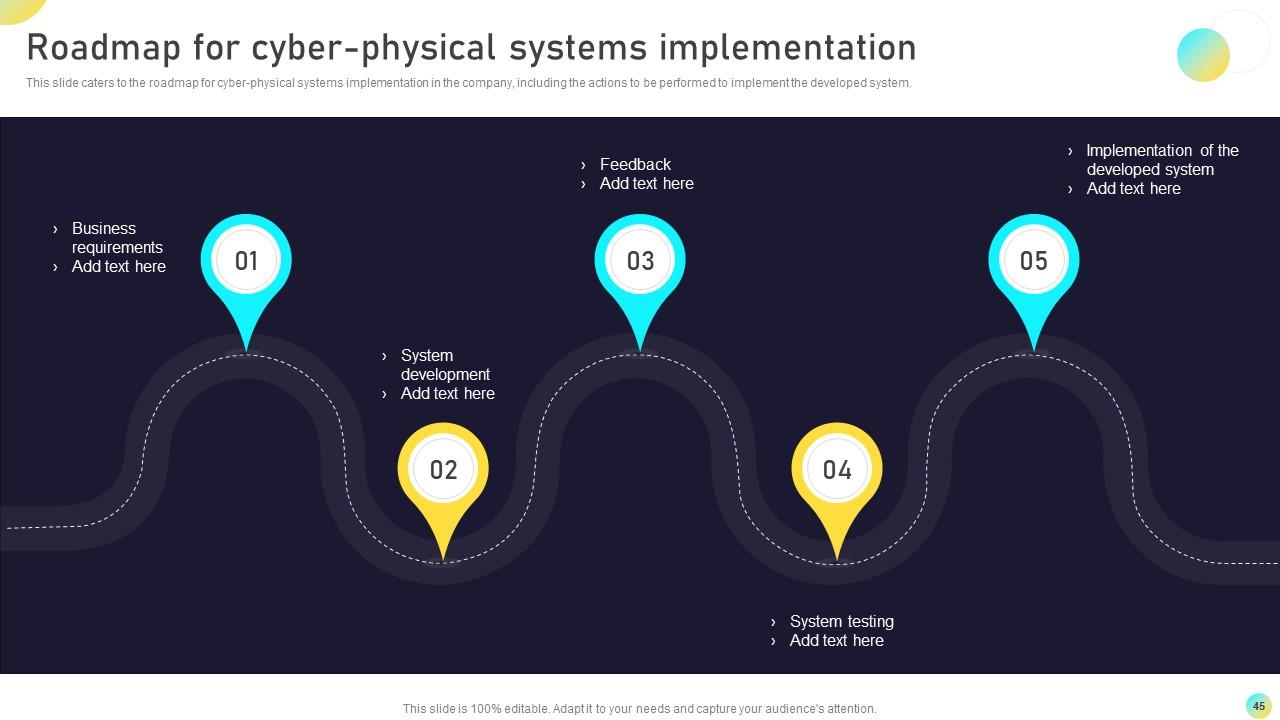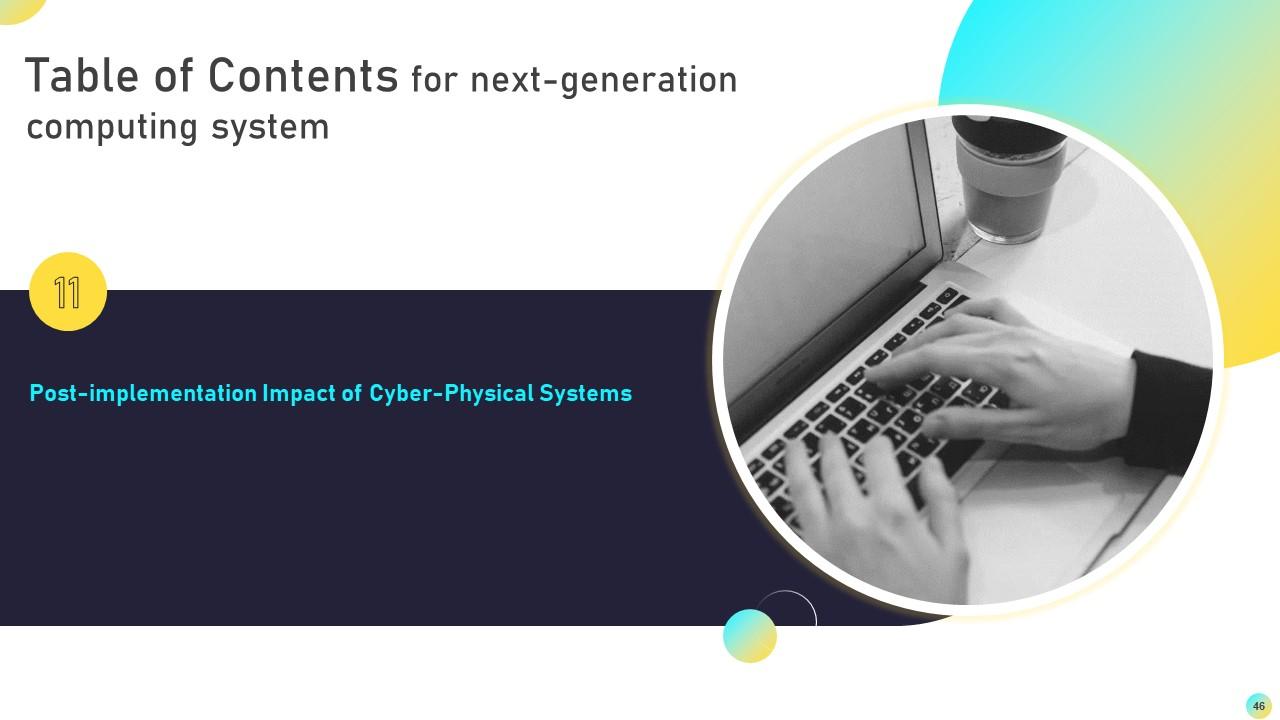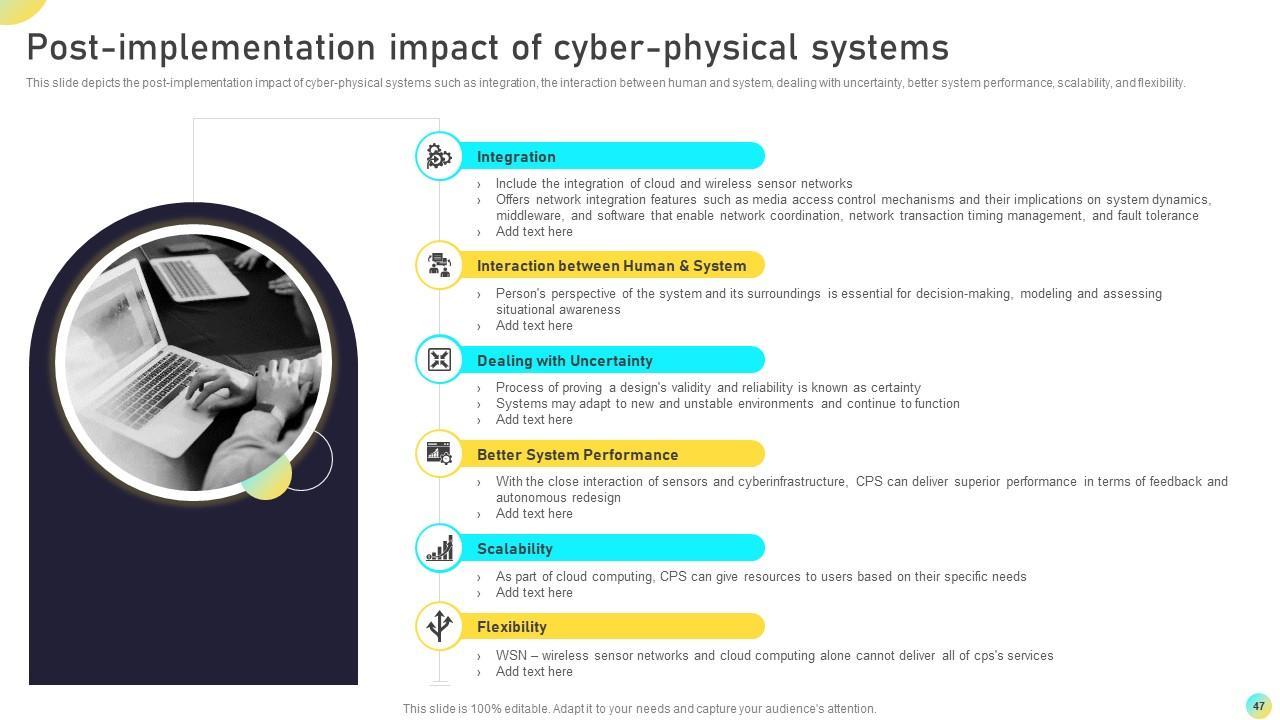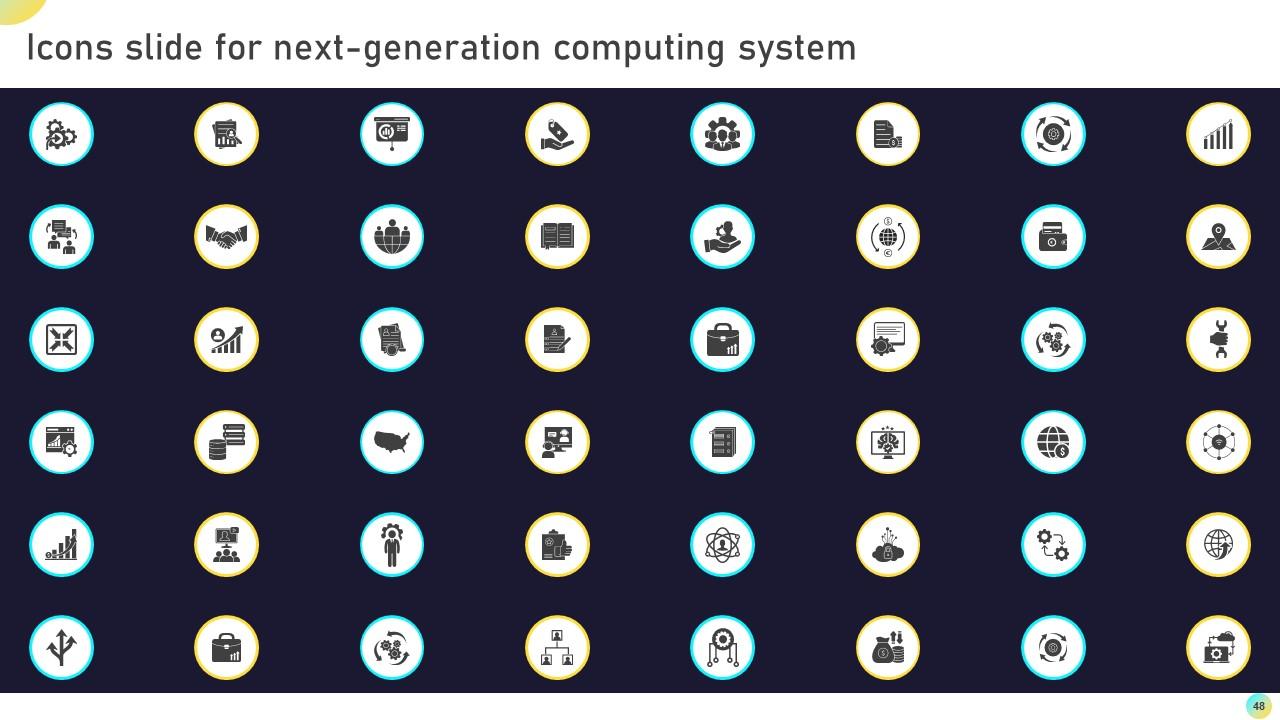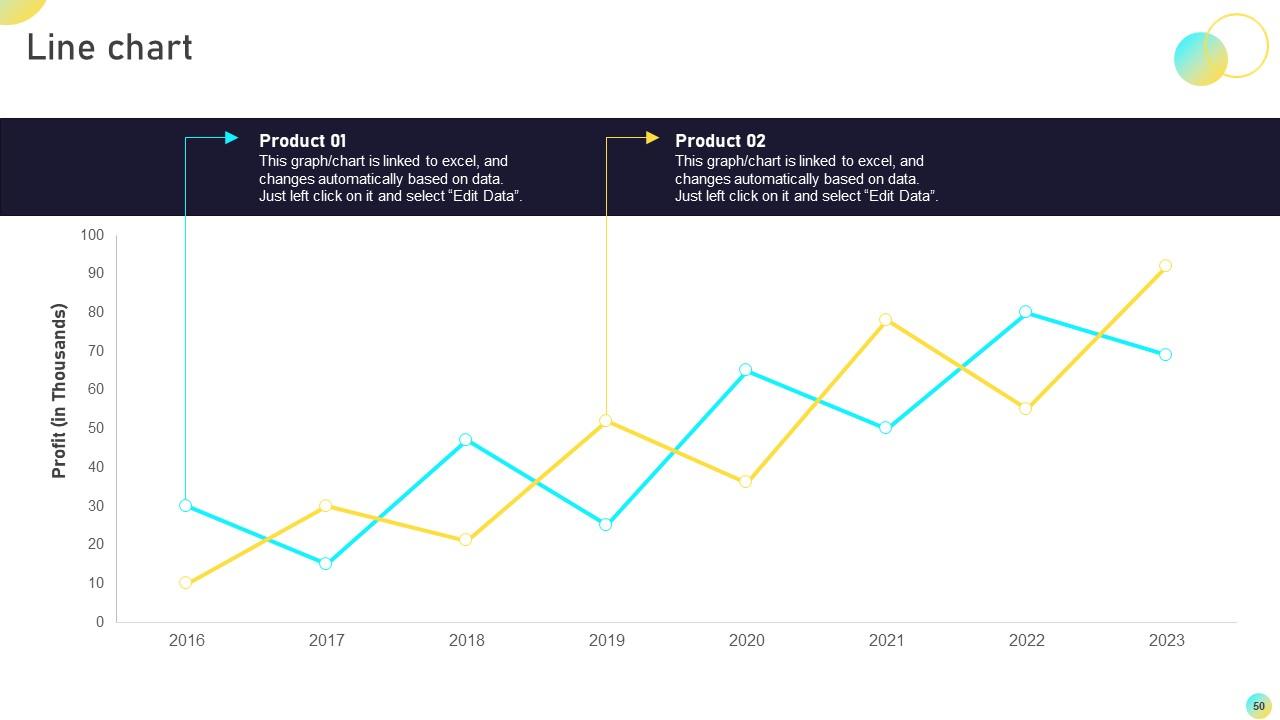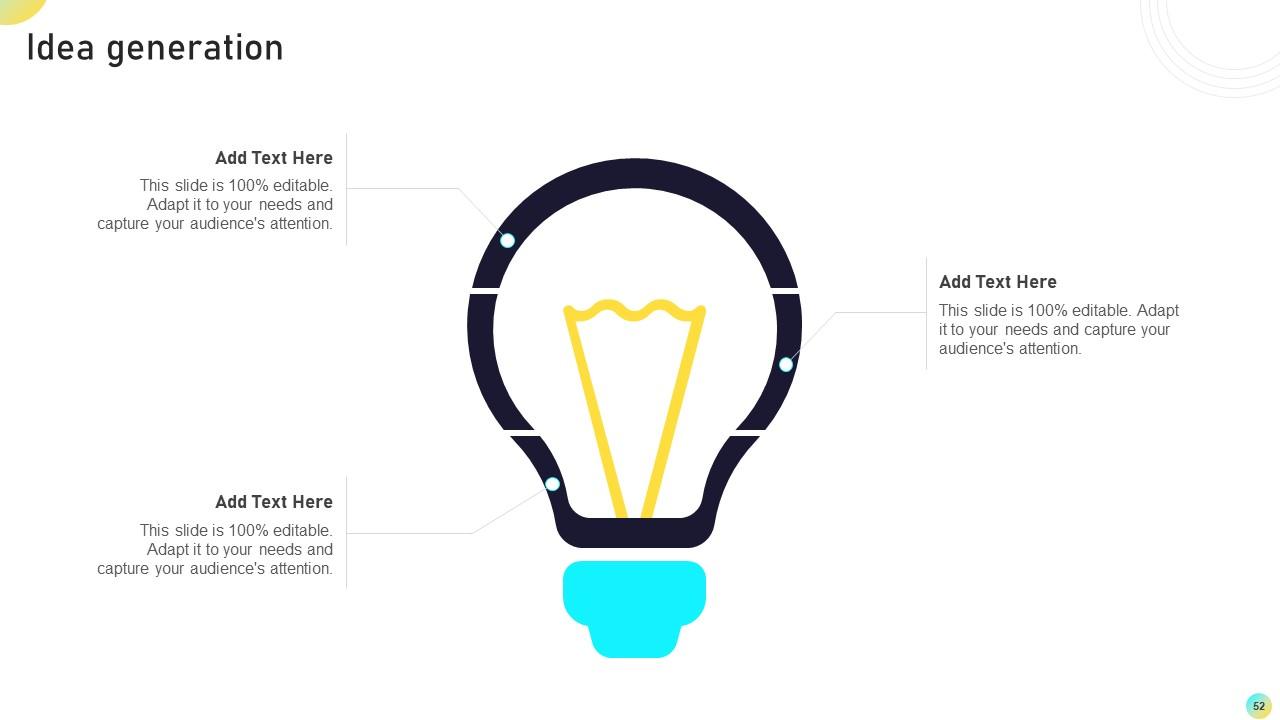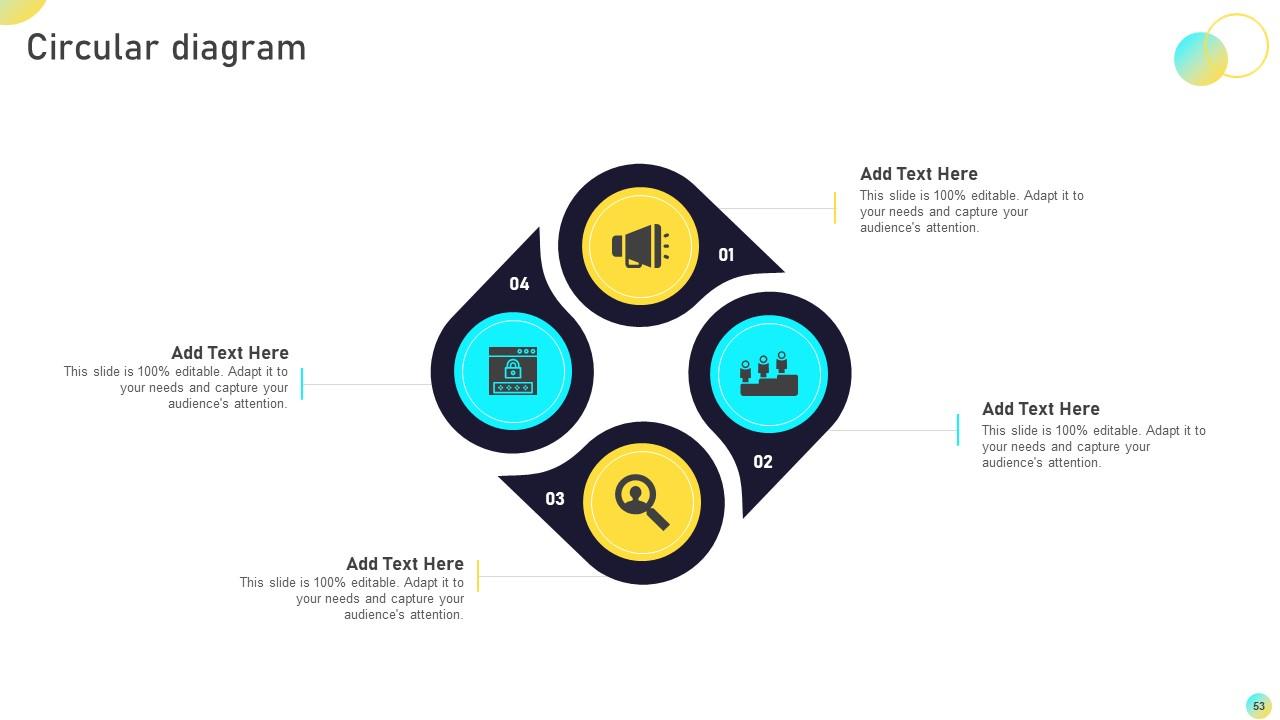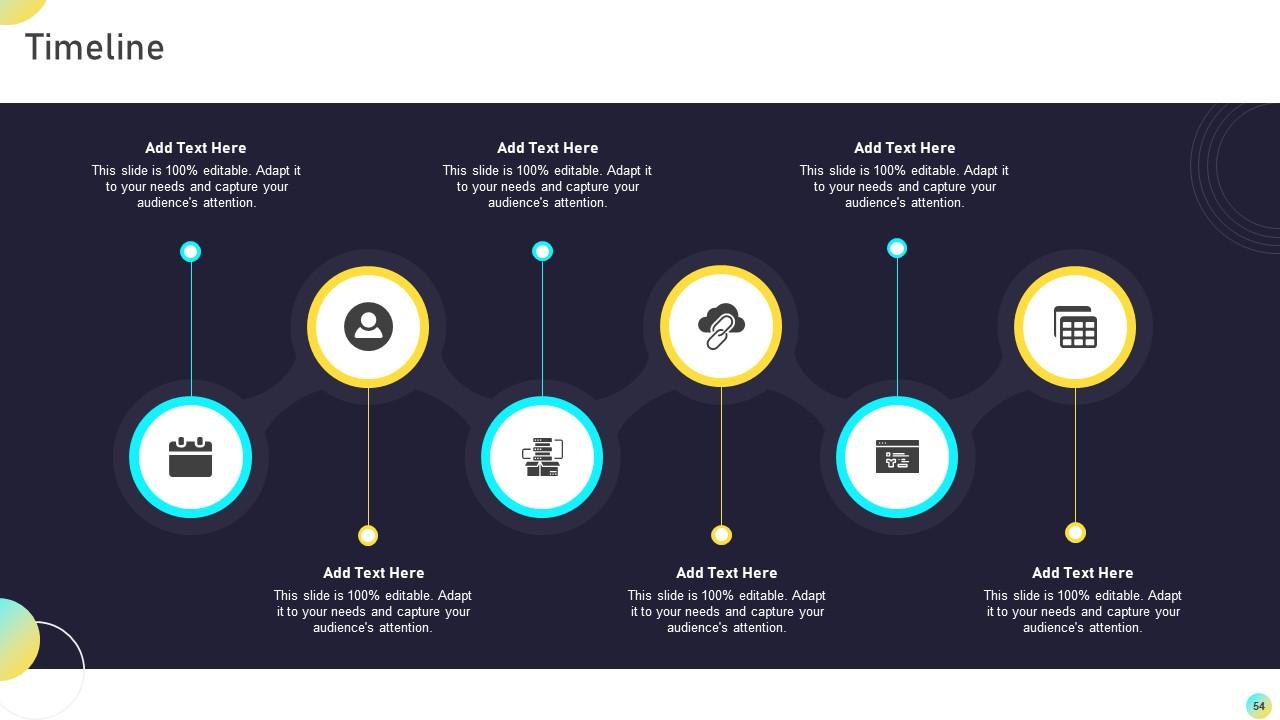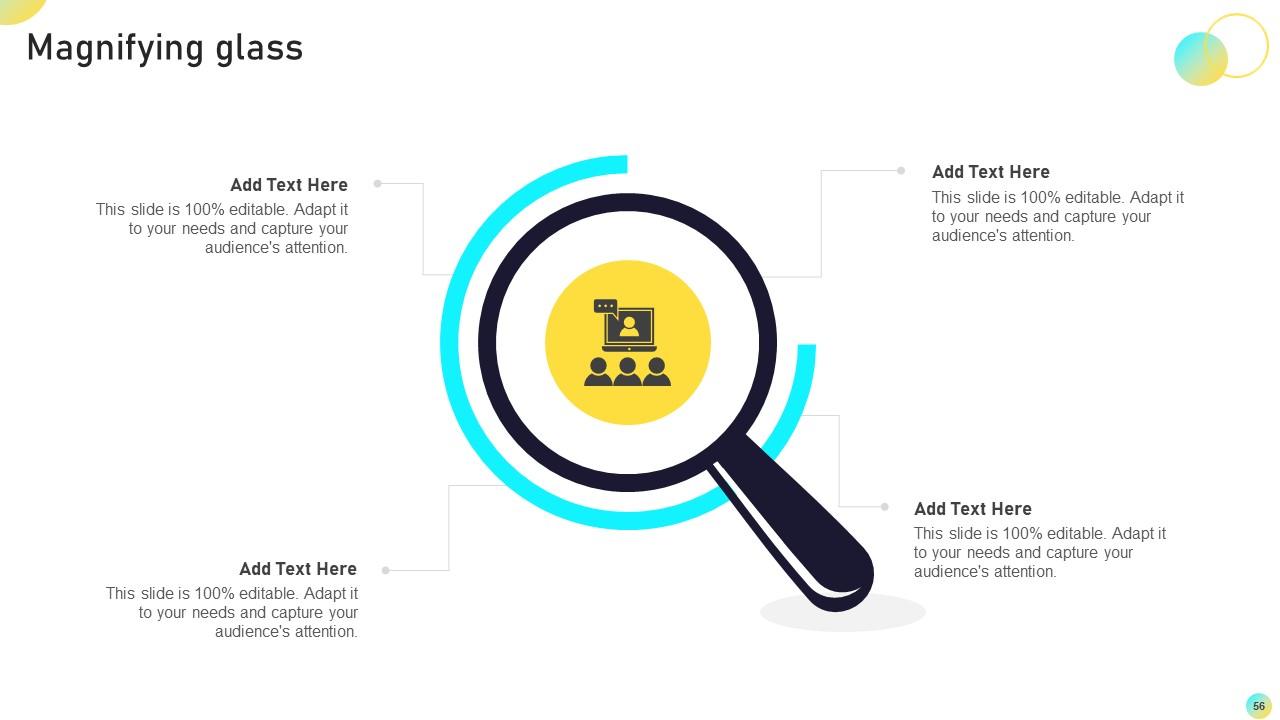Next Generation Computing System Powerpoint Presentation Slides
This template gives a brief idea about the CPS provider company and the transformation of the companys operations with cyber-physical systems for effective service delivery. In this Next-Generation Computing System PowerPoint Presentation, we have covered the introduction to cyber-physical systems, including their features and global market size. In addition, this Intelligent System PPT contains the components of the CPS, such as sensing and controlling components, 5C architecture, and 8C proposed architecture. Also, the Next Generation Computing System PPT presentation includes the various types of CPS, working, and application of CPS in different sectors such as a smart greenhouse, manufacturing, water distribution, healthcare, etc. Furthermore, this Collective Intelligence Systems template caters to security in cyber-physical systems and pricing for the CPS services. Lastly, this Cyber-Physical Systems deck comprises the 30-60-90 days development plan, roadmap, and impact post-implementation on businesses. Download our 100 percent editable and customizable template, which is also compatible with Google Slides.
This template gives a brief idea about the CPS provider company and the transformation of the companys operations with cybe..
- Google Slides is a new FREE Presentation software from Google.
- All our content is 100% compatible with Google Slides.
- Just download our designs, and upload them to Google Slides and they will work automatically.
- Amaze your audience with SlideTeam and Google Slides.
-
Want Changes to This PPT Slide? Check out our Presentation Design Services
- WideScreen Aspect ratio is becoming a very popular format. When you download this product, the downloaded ZIP will contain this product in both standard and widescreen format.
-

- Some older products that we have may only be in standard format, but they can easily be converted to widescreen.
- To do this, please open the SlideTeam product in Powerpoint, and go to
- Design ( On the top bar) -> Page Setup -> and select "On-screen Show (16:9)” in the drop down for "Slides Sized for".
- The slide or theme will change to widescreen, and all graphics will adjust automatically. You can similarly convert our content to any other desired screen aspect ratio.
Compatible With Google Slides

Get This In WideScreen
You must be logged in to download this presentation.
PowerPoint presentation slides
Deliver an informational PPT on various topics by using this Next Generation Computing System Powerpoint Presentation Slides. This deck focuses and implements best industry practices, thus providing a birds-eye view of the topic. Encompassed with fifty seven slides, designed using high-quality visuals and graphics, this deck is a complete package to use and download. All the slides offered in this deck are subjective to innumerable alterations, thus making you a pro at delivering and educating. You can modify the color of the graphics, background, or anything else as per your needs and requirements. It suits every business vertical because of its adaptable layout.
People who downloaded this PowerPoint presentation also viewed the following :
Content of this Powerpoint Presentation
Slide 1: This slide introduces Next-Generation Computing System. State your company name and begin.
Slide 2: This slide states Agenda of the presentation.
Slide 3: This slide presents Table of Content for the presentation.
Slide 4: This slide highlights title for topics that are to be covered next in the template.
Slide 5: This slide describes the overview of the company.
Slide 6: This slide displays Statistics of the CPS Provider Company.
Slide 7: This slide highlights title for topics that are to be covered next in the template.
Slide 8: This slide represents Cyber-Physical Systems Overview.
Slide 9: This slide depicts the features of cyber-physical systems, including self-documenting, self-monitoring, etc.
Slide 10: This slide showcases Global Cyber-Physical Systems Market Share.
Slide 11: This slide highlights title for topics that are to be covered next in the template.
Slide 12: This slide shows Sensing Components of Cyber-Physical Systems.
Slide 13: This slide presents Controlling Components of Cyber-Physical Systems.
Slide 14: This slide highlights title for topics that are to be covered next in the template.
Slide 15: This slide describes the application layer of cyber-physical system architecture.
Slide 16: This slide describes the network layer of cyber-physical system architecture.
Slide 17: This slide represents the physical layer of cyber-physical system architecture.
Slide 18: This slide showcases the 5C architecture of cyber-physical systems.
Slide 19: This slide shows the proposed 8C architecture of cyber-physical systems.
Slide 20: This slide presents Concept Map of Cyber-Physical Systems.
Slide 21: This slide highlights title for topics that are to be covered next in the template.
Slide 22: This slide displays Timed Actor Cyber-Physical Systems Model.
Slide 23: This slide represents Event-based Cyber-Physical Systems Model.
Slide 24: This slide showcases Lattice-based Event Cyber-Physical Systems Model.
Slide 25: This slide shows Hybrid-based Cyber-Physical Systems Model.
Slide 26: This slide highlights title for topics that are to be covered next in the template.
Slide 27: This slide covers the working of cyber-physical systems.
Slide 28: This slide describes the cyber-physical systems in the smart greenhouse.
Slide 29: This slide represents the application of CPS in manufacturing.
Slide 30: This slide showcases Cyber-Physical Systems in Water Distribution Systems.
Slide 31: This slide describes the application of CPS in the healthcare industry.
Slide 32: This slide depicts the application of CPS in claytronic, including its purpose, method of creation, etc.
Slide 33: This slide represents Cyber-Physical Systems in Smart Transportation Systems.
Slide 34: This slide describes the usage of cyber-physical systems in smart grids.
Slide 35: This slide highlights title for topics that are to be covered next in the template.
Slide 36: This slide shows Safety and Security Objectives in Cyber-Physical Systems.
Slide 37: This slide depicts the cyber-physical systems security and privacy life cycle.
Slide 38: This slide presents Security Strategic Planning Process for CPS.
Slide 39: This slide displays Steps for CPS Security Strategy Plan.
Slide 40: This slide highlights title for topics that are to be covered next in the template.
Slide 41: This slide represents Pricing for Cyber-Physical Systems Development.
Slide 42: This slide highlights title for topics that are to be covered next in the template.
Slide 43: This slide showcases 30-60-90 Days Plan for CPS Development.
Slide 44: This slide highlights title for topics that are to be covered next in the template.
Slide 45: This slide shows Roadmap for Cyber-Physical Systems Implementation.
Slide 46: This slide highlights title for topics that are to be covered next in the template.
Slide 47: This slide presents Post-implementation Impact of Cyber-Physical Systems.
Slide 48: This slide contains all the icons used in this presentation.
Slide 49: This slide is titled as Additional Slides for moving forward.
Slide 50: This slide describes Line chart with two products comparison.
Slide 51: This slide contains Puzzle with related icons and text.
Slide 52: This is an Idea Generation slide to state a new idea or highlight information, specifications etc.
Slide 53: This slide shows Circular Diagram with additional textboxes.
Slide 54: This is a Timeline slide. Show data related to time intervals here.
Slide 55: This slide depicts Venn diagram with text boxes.
Slide 56: This slide showcases Magnifying Glass to highlight information, specifications etc
Slide 57: This is a Thank You slide with address, contact numbers and email address.
Next Generation Computing System Powerpoint Presentation Slides with all 62 slides:
Use our Next Generation Computing System Powerpoint Presentation Slides to effectively help you save your valuable time. They are readymade to fit into any presentation structure.
FAQs
Cyber-physical systems are physical systems that are integrated with software and network technologies to facilitate communication and interaction between the physical and cyber worlds.
Cyber-physical systems are self-monitoring, self-documenting, and self-configuring. They also have the ability to make real-time decisions and adapt to changing environments.
Cyber-physical systems have a wide range of applications, including in manufacturing, healthcare, transportation, smart grids, and water distribution systems.
Security can be ensured in cyber-physical systems through a strategic planning process, including steps such as threat analysis, risk assessment, and security testing.
The roadmap for implementing cyber-physical systems involves several stages, including development, testing, deployment, and post-implementation evaluation, to ensure that the systems meet their intended objectives.
-
Appreciate the research and its presentable format.
-
What an exhaustive collection of templates you guys have there in slideteam. Impressive!!!


